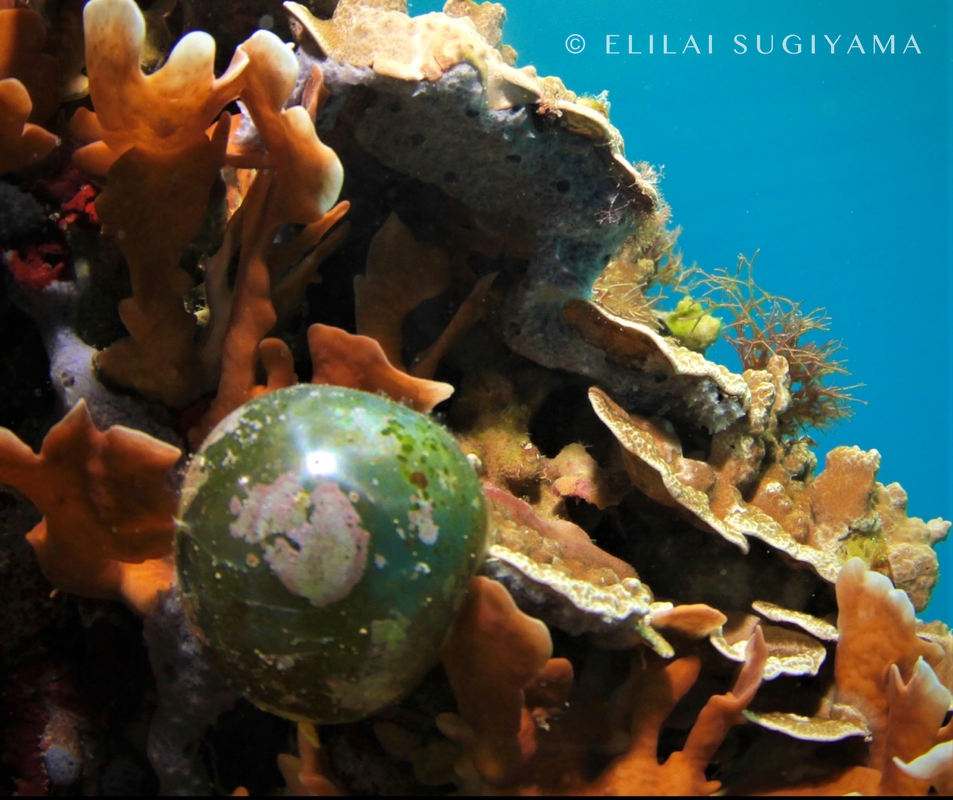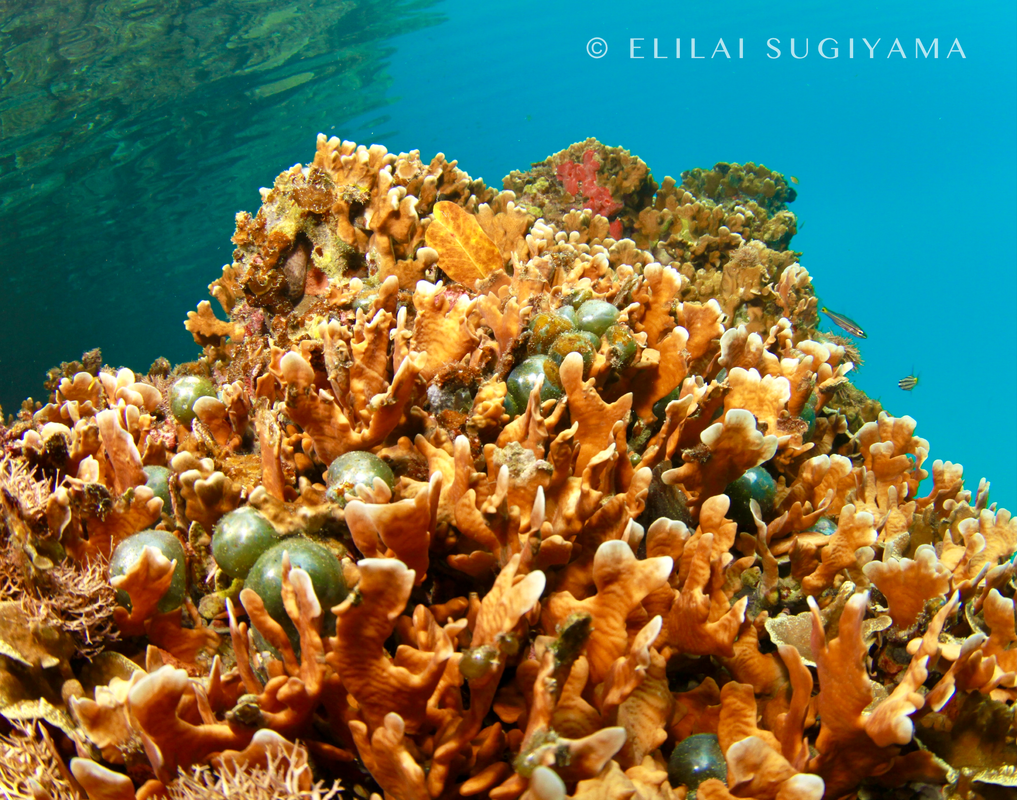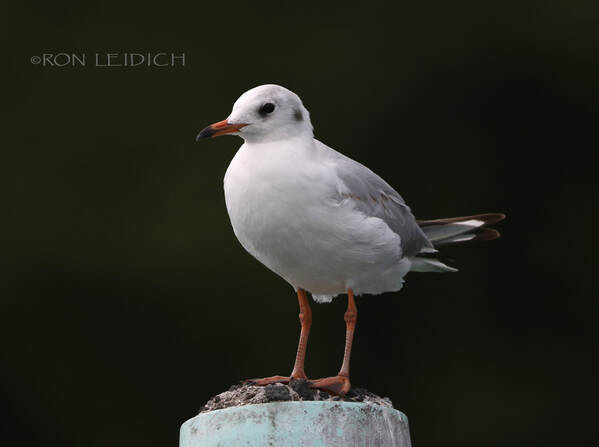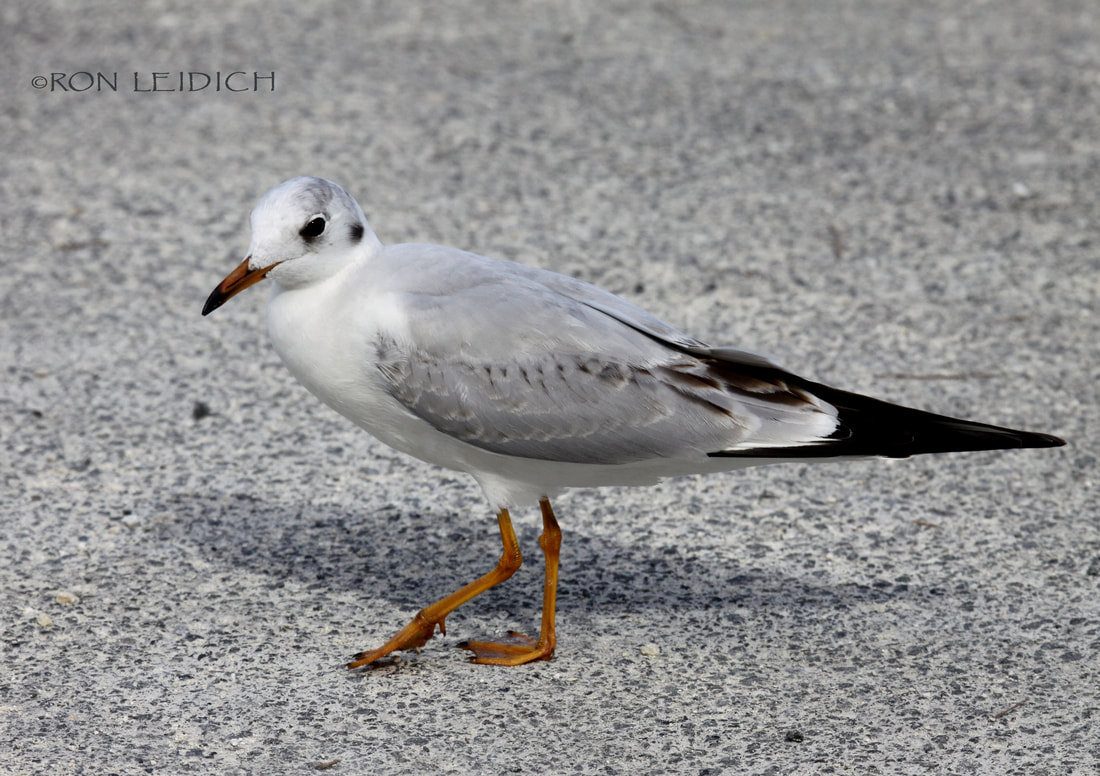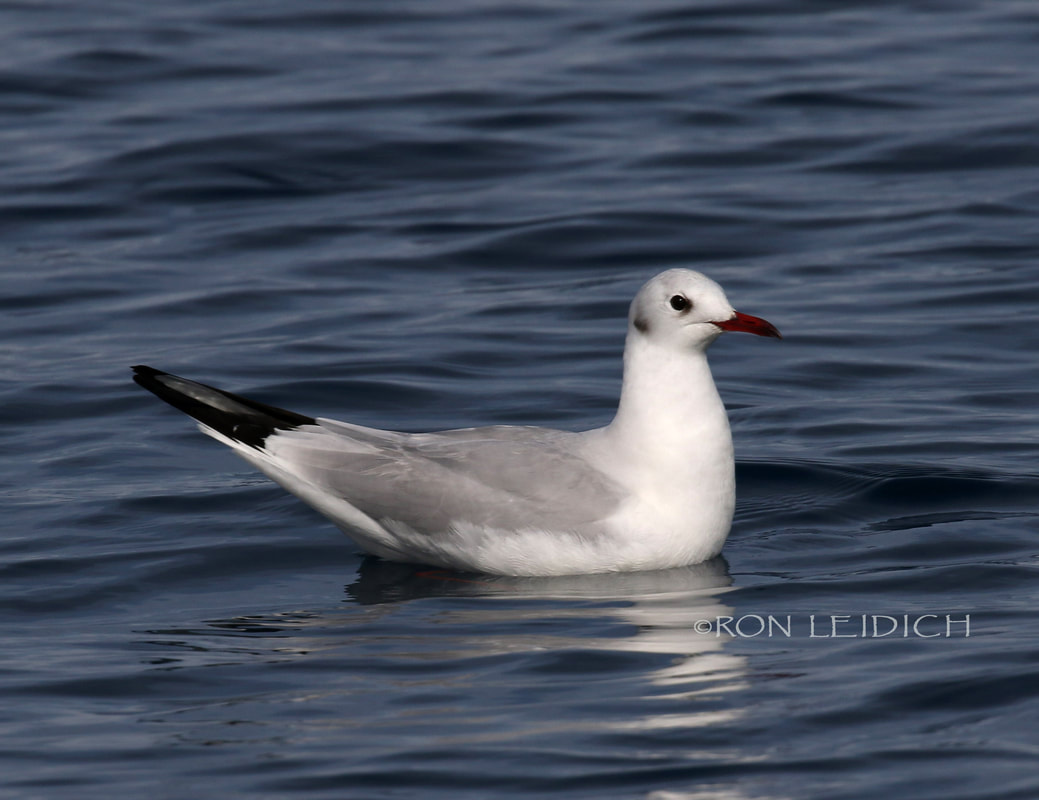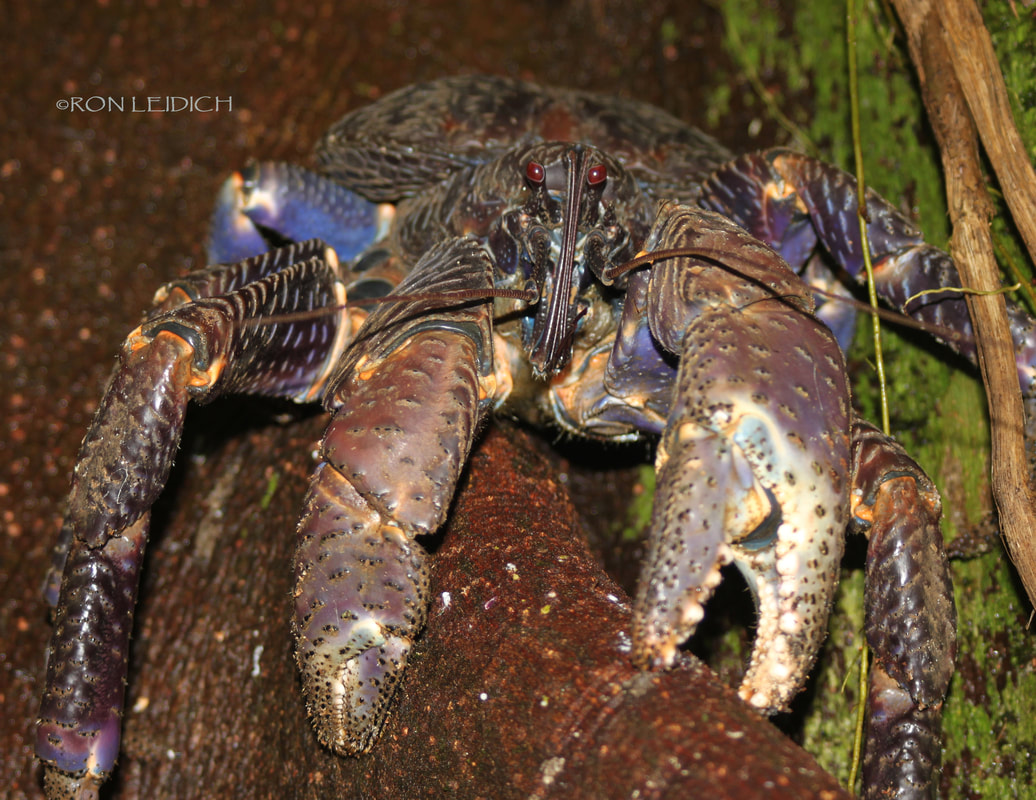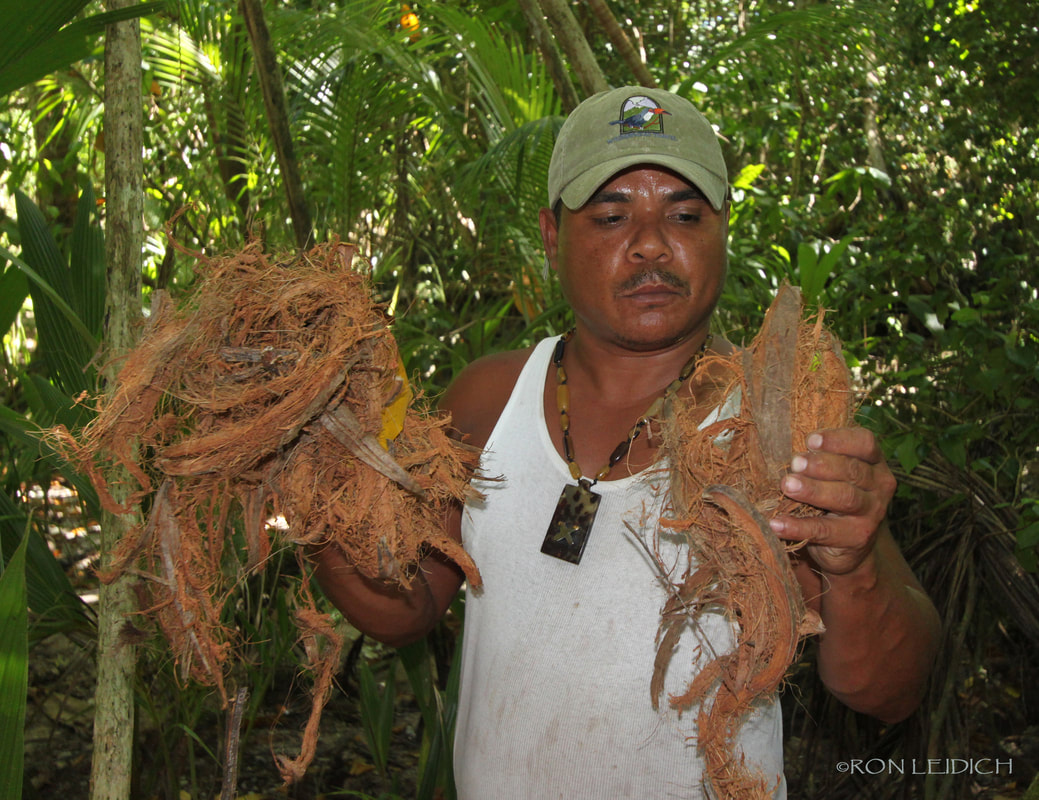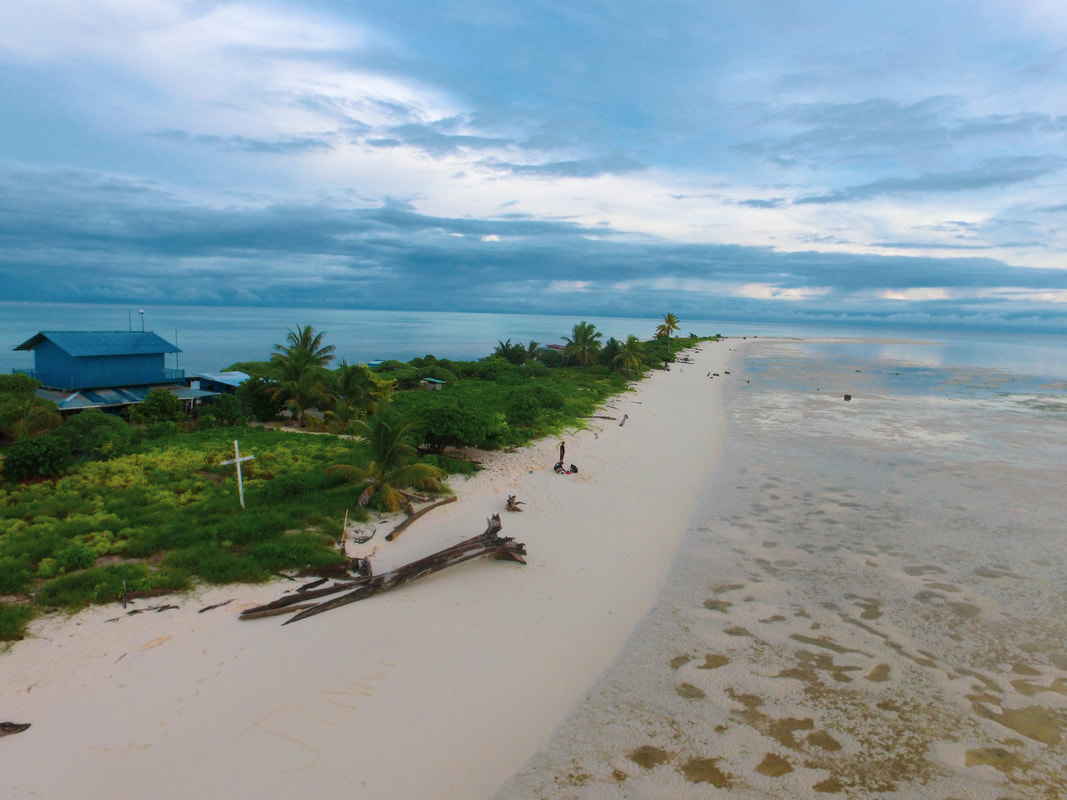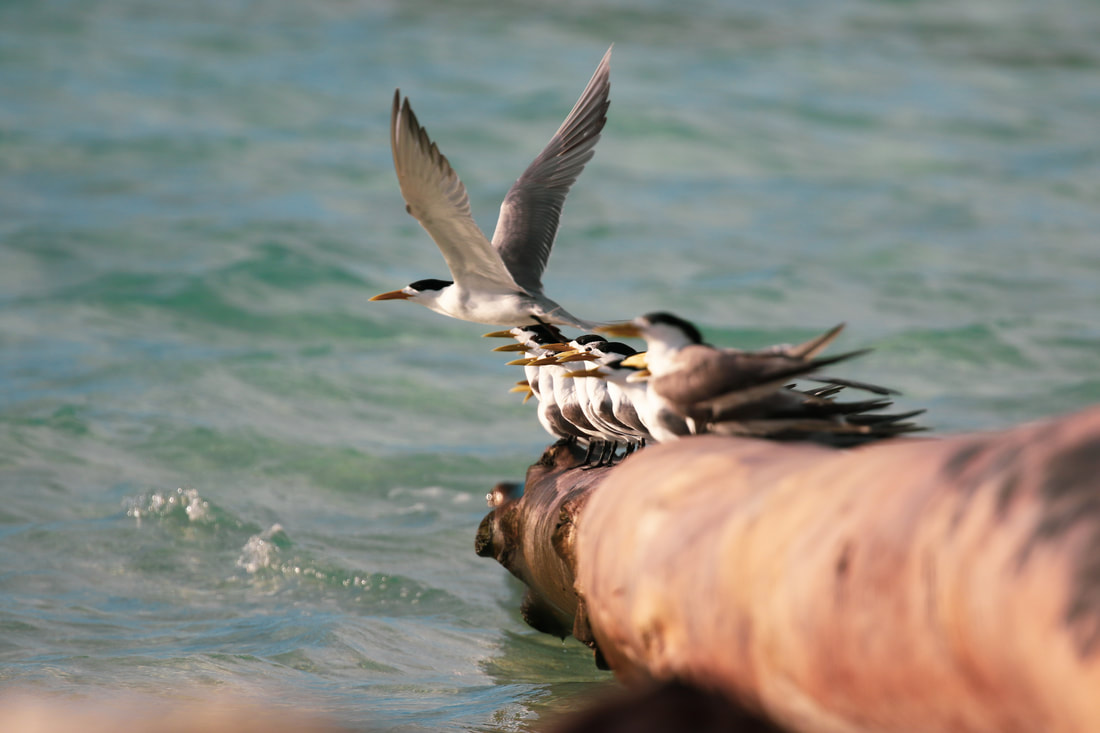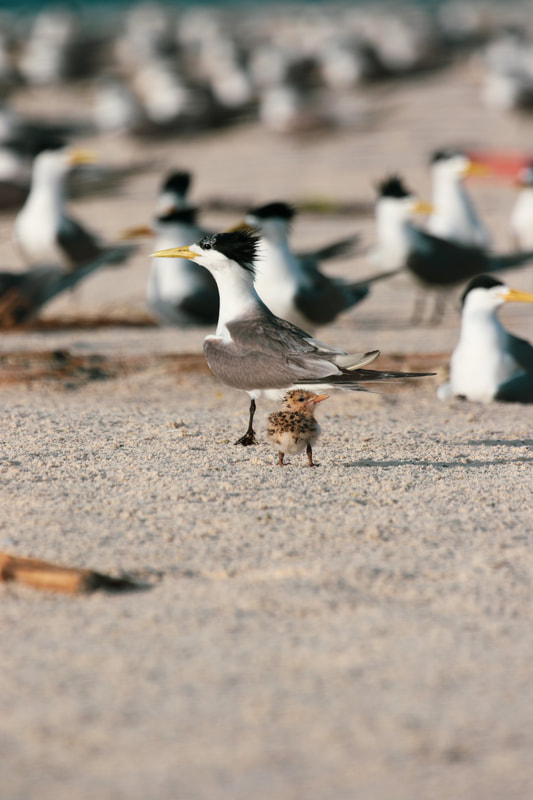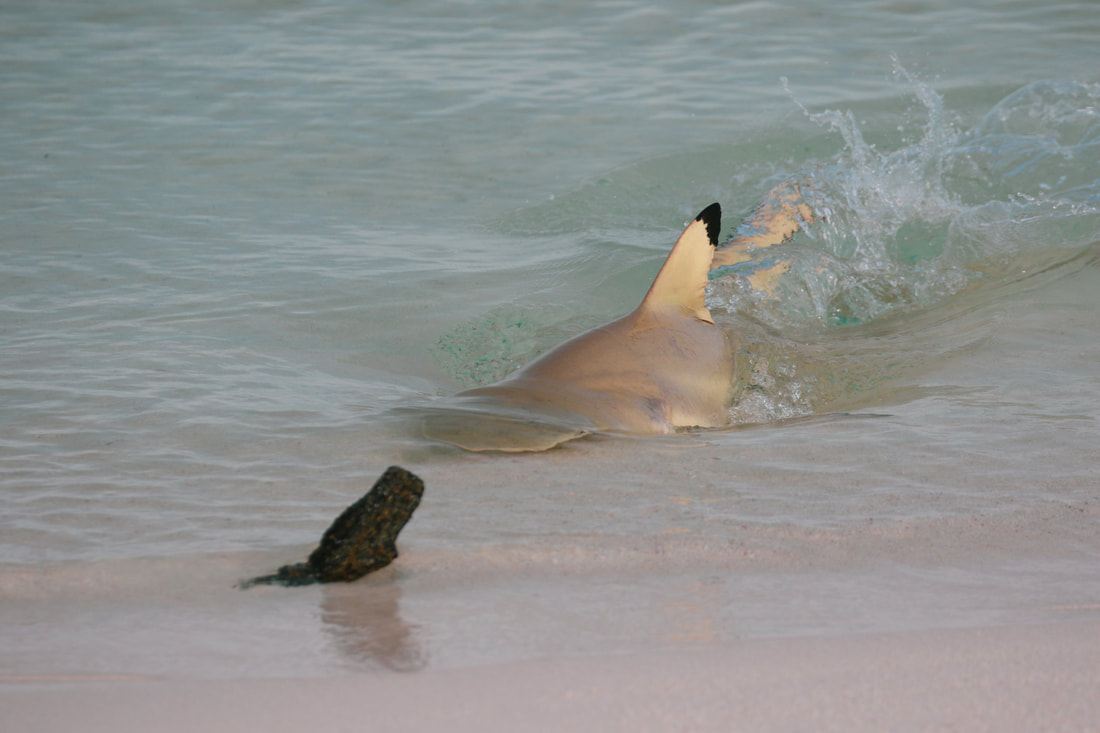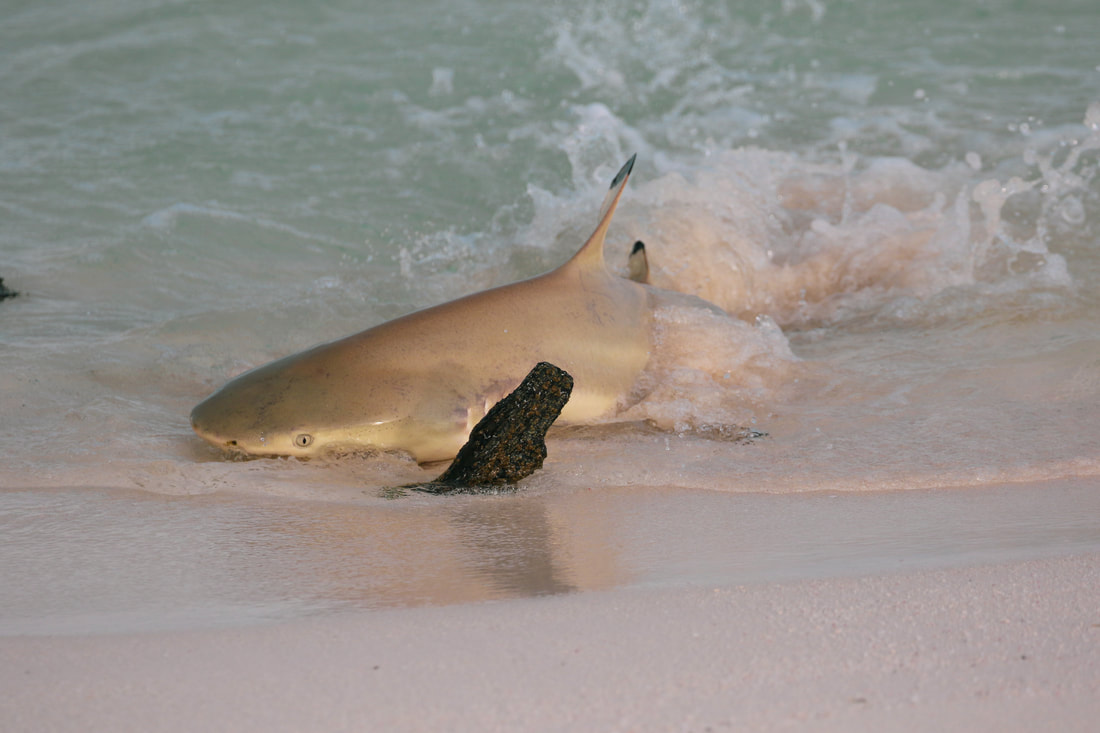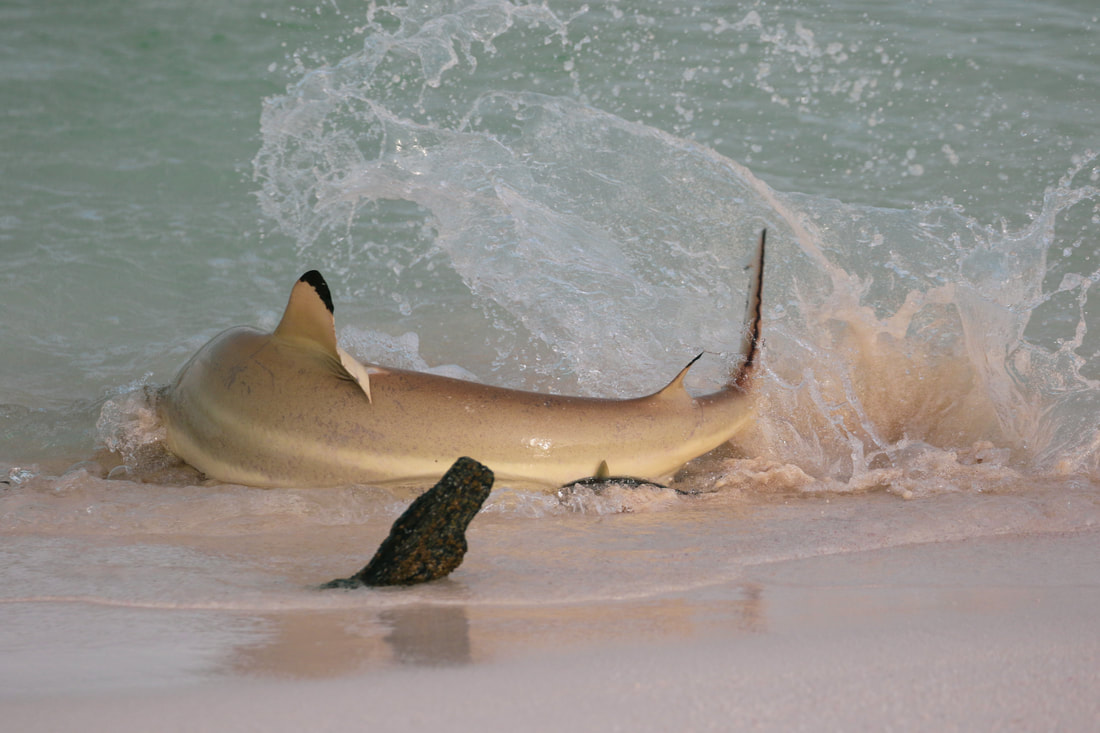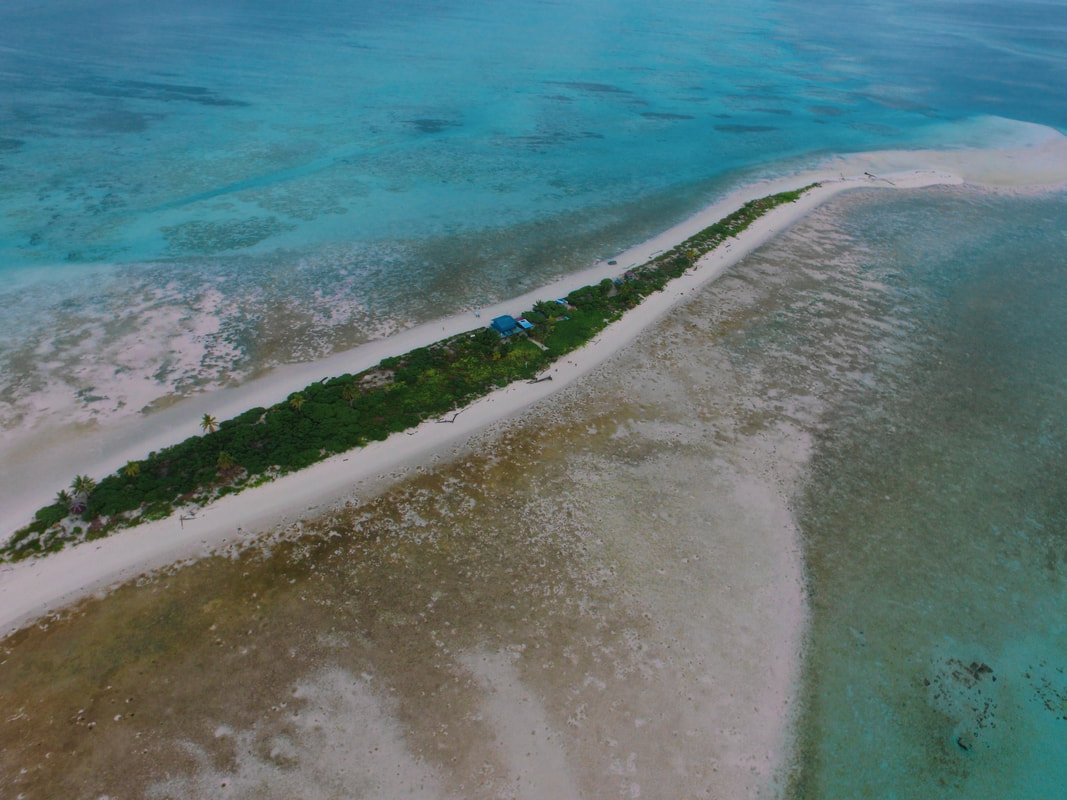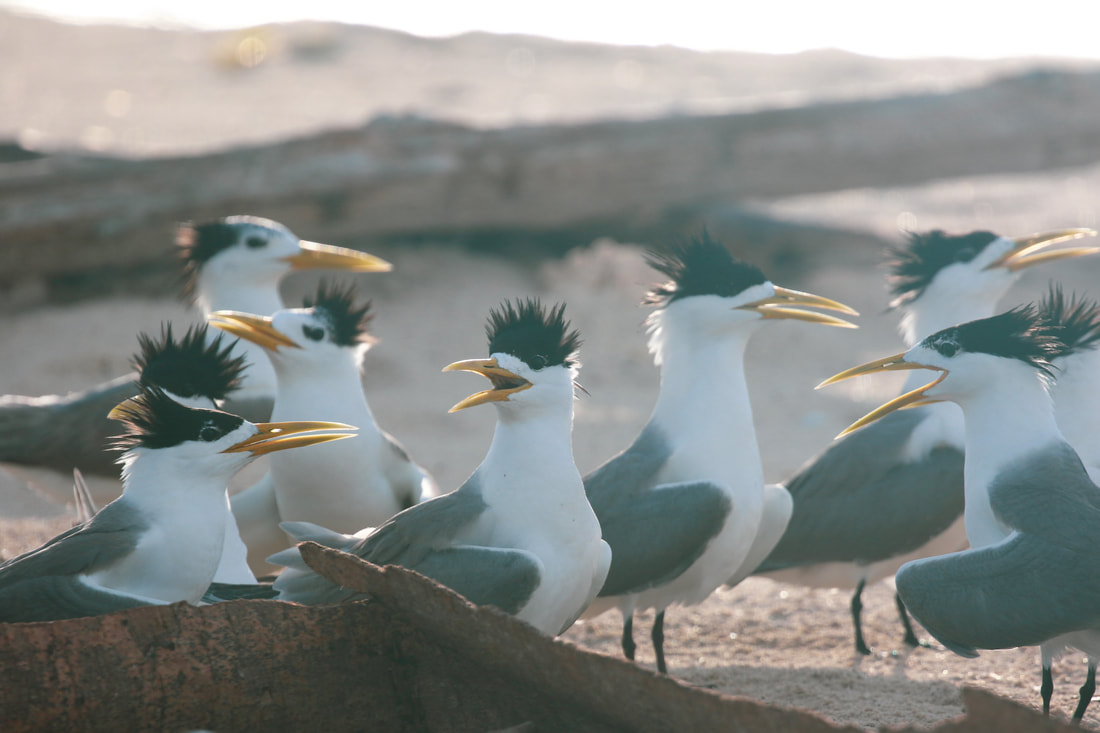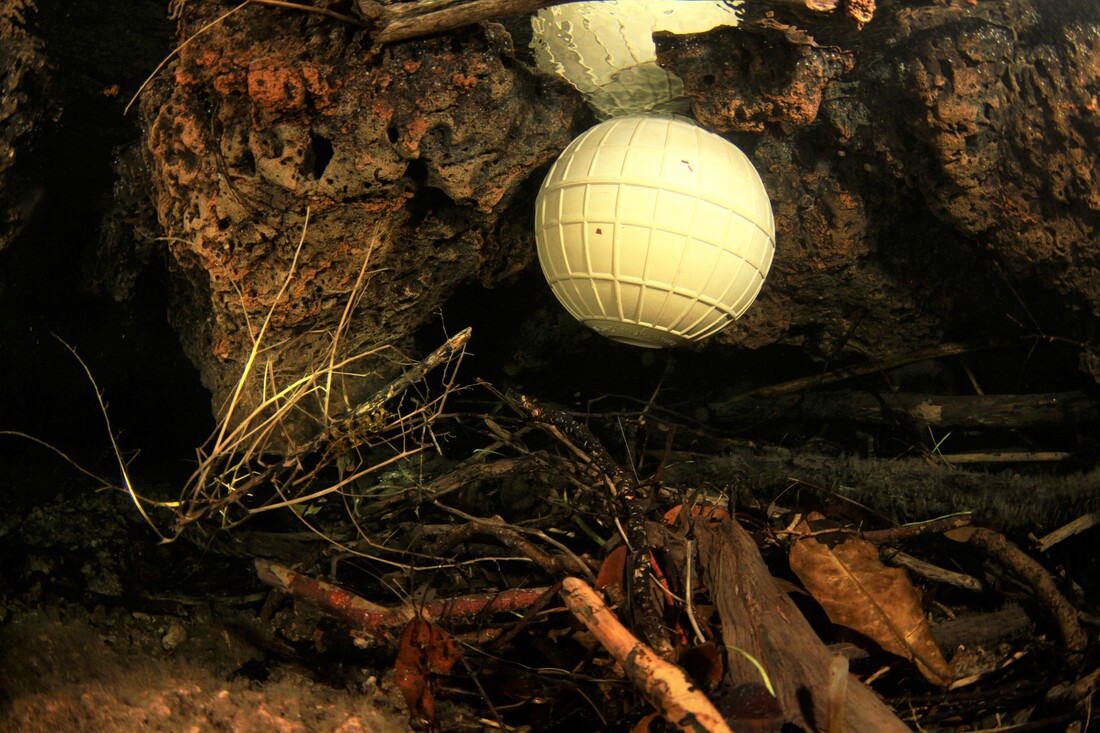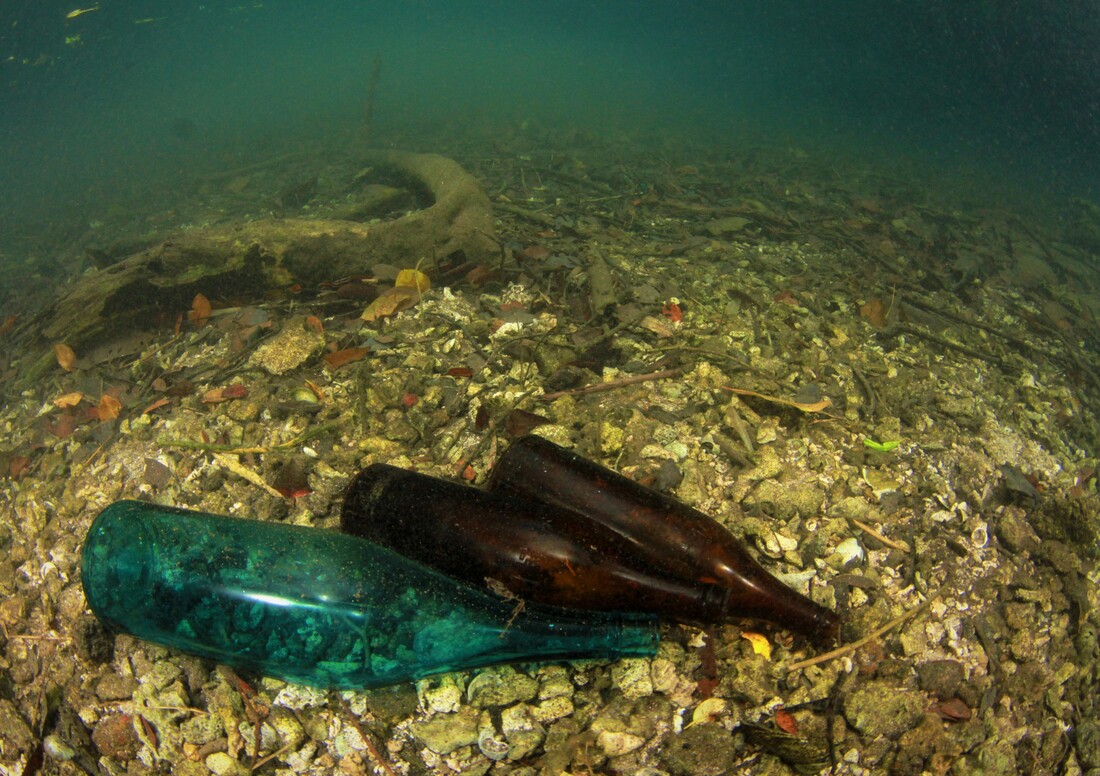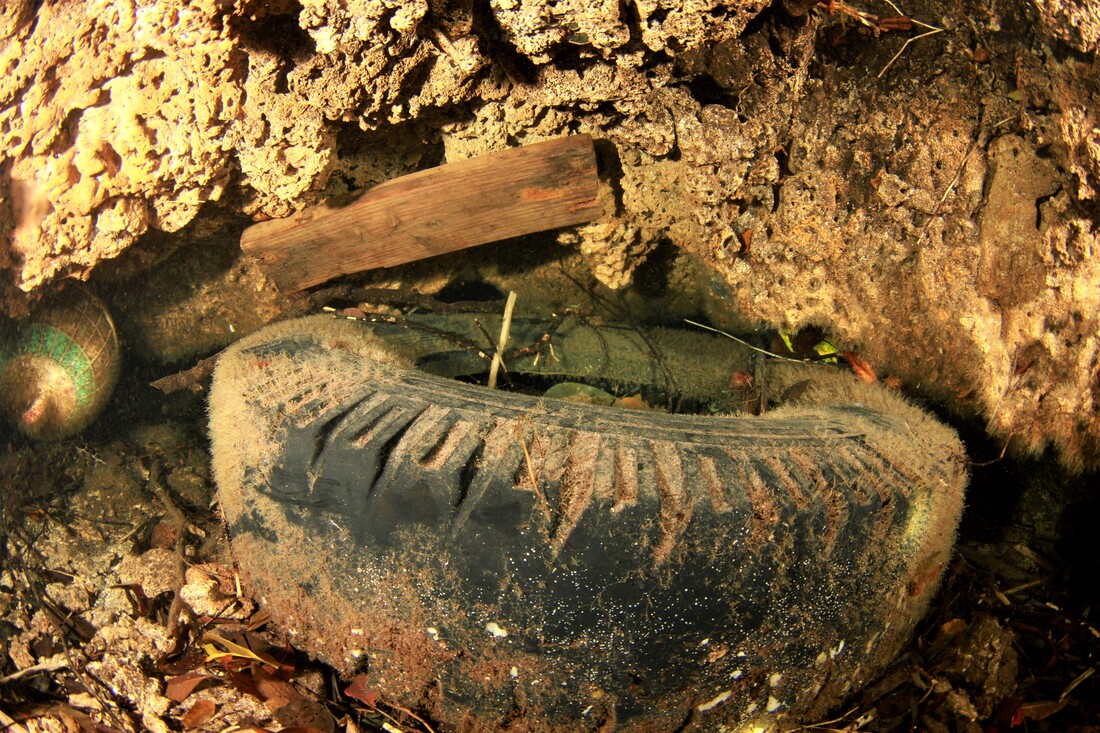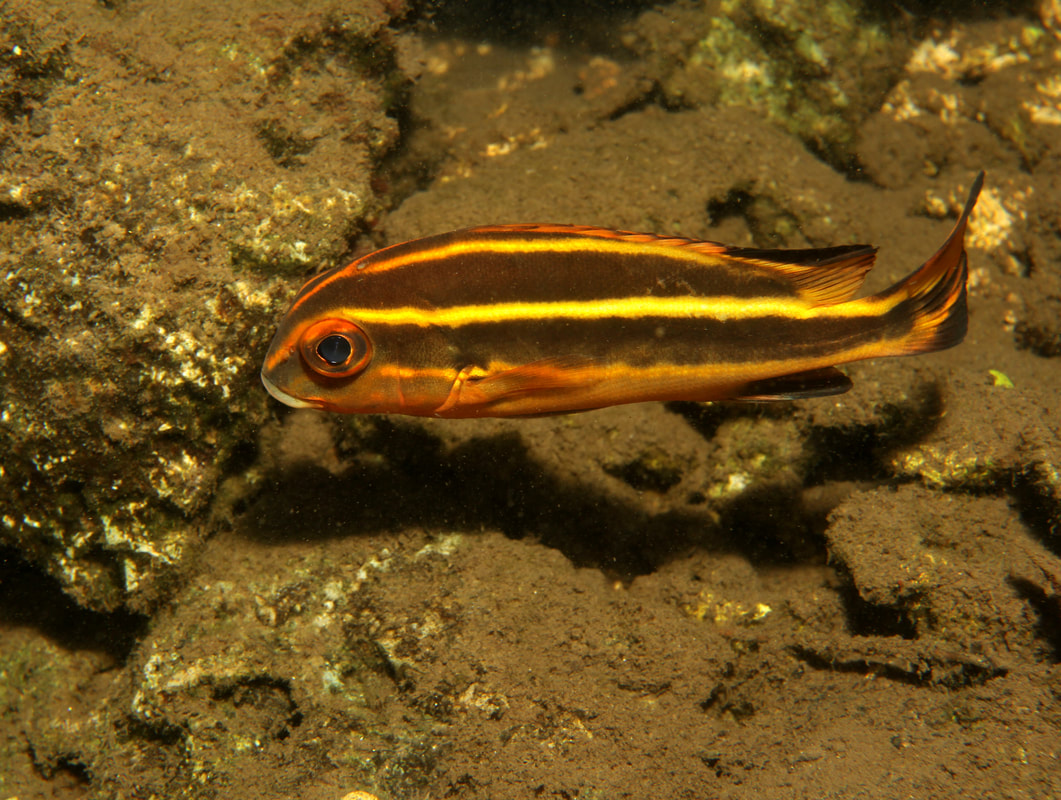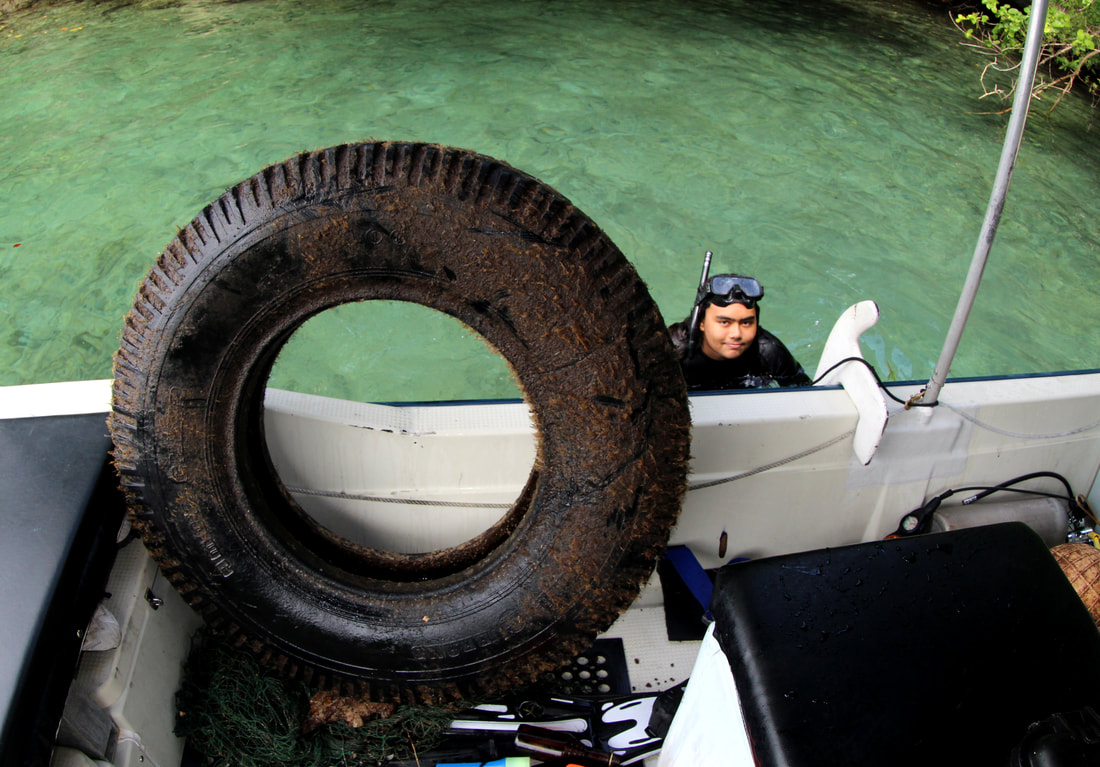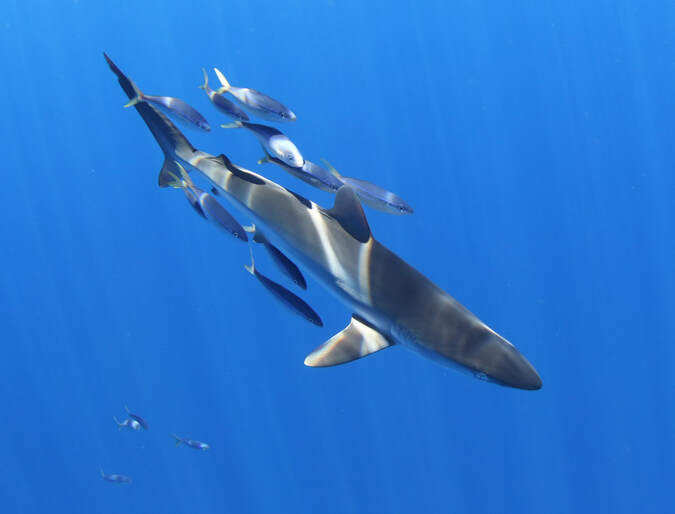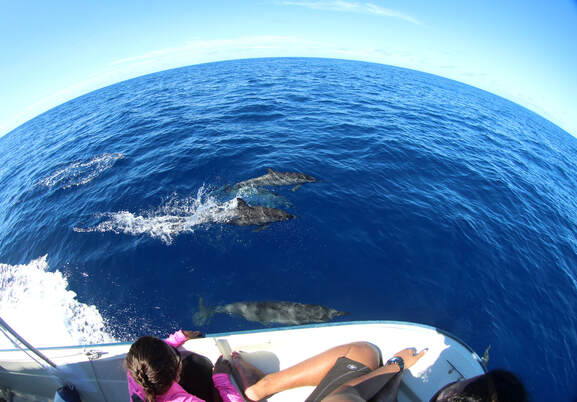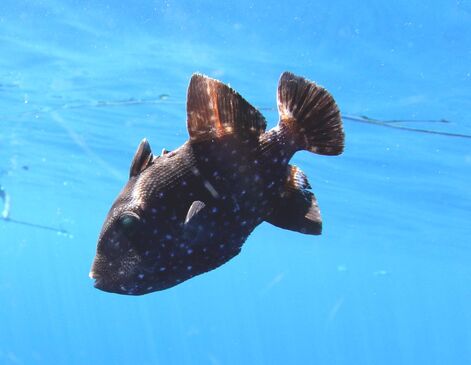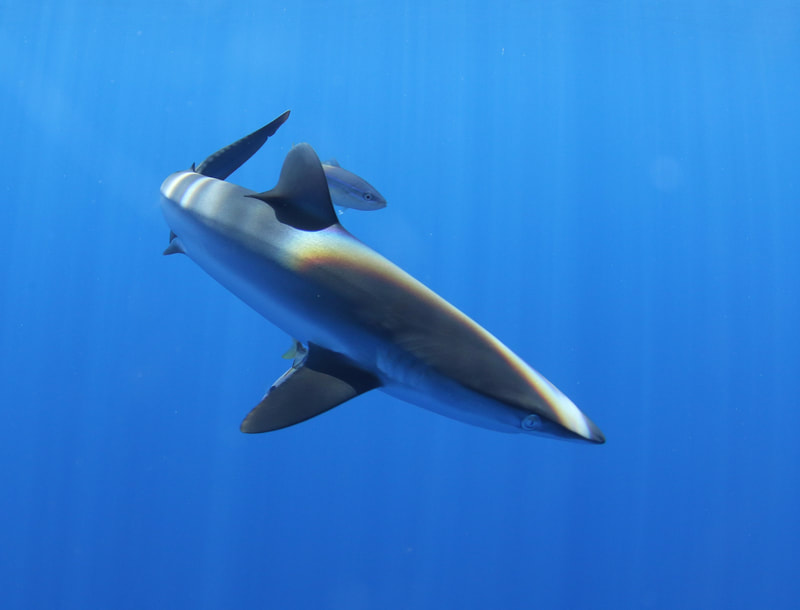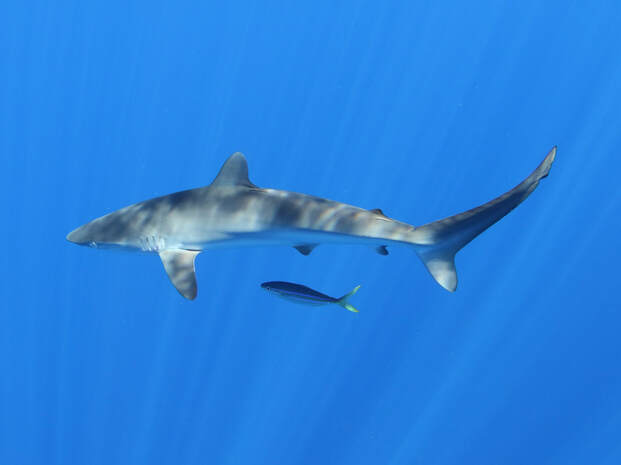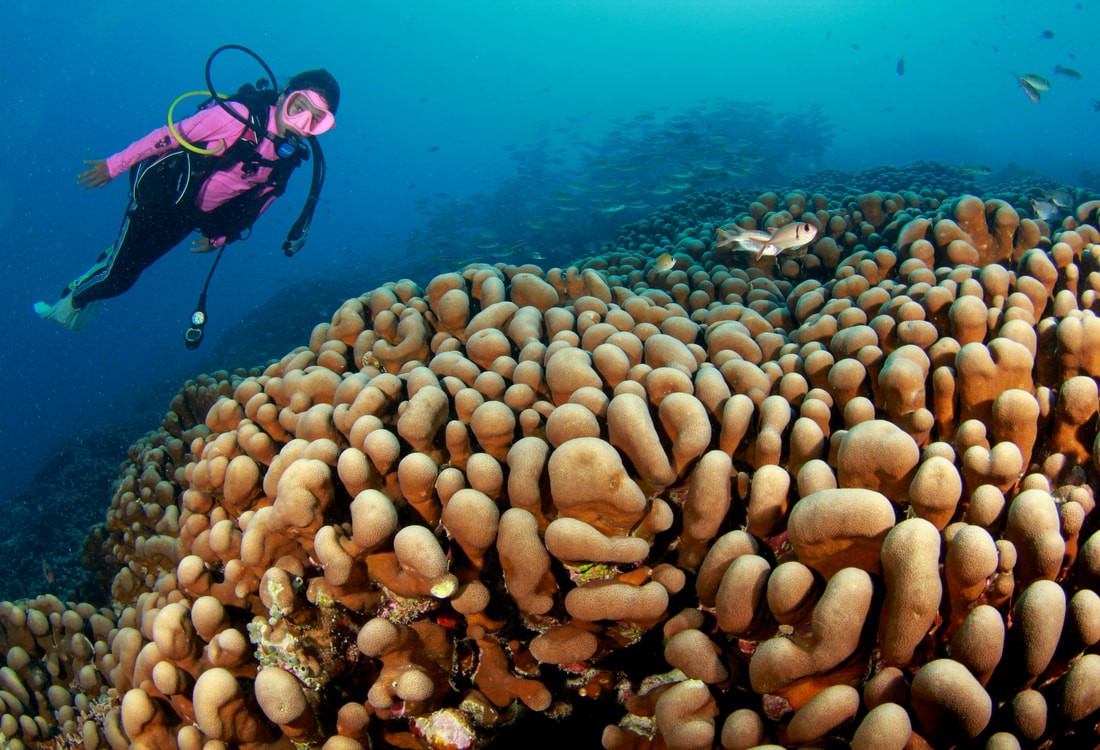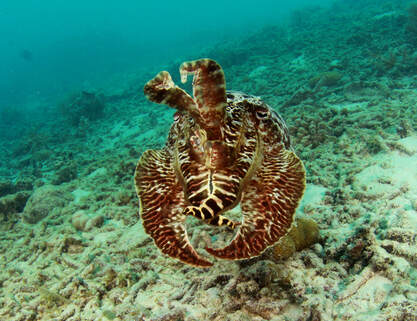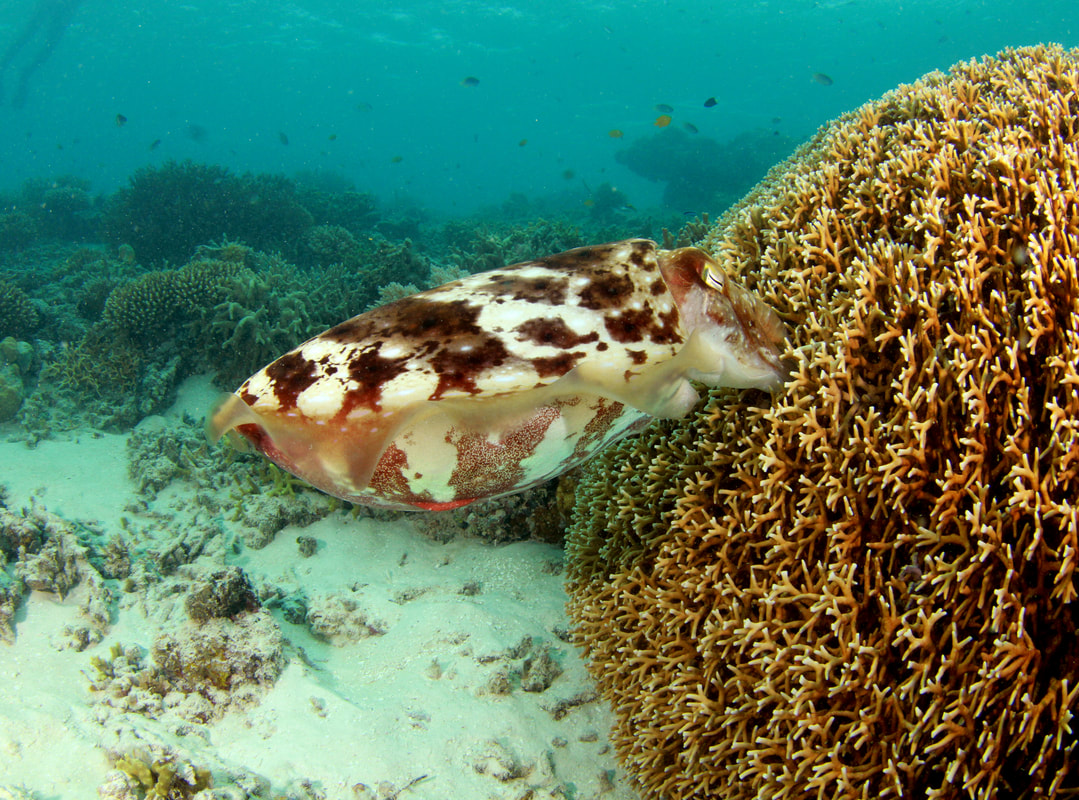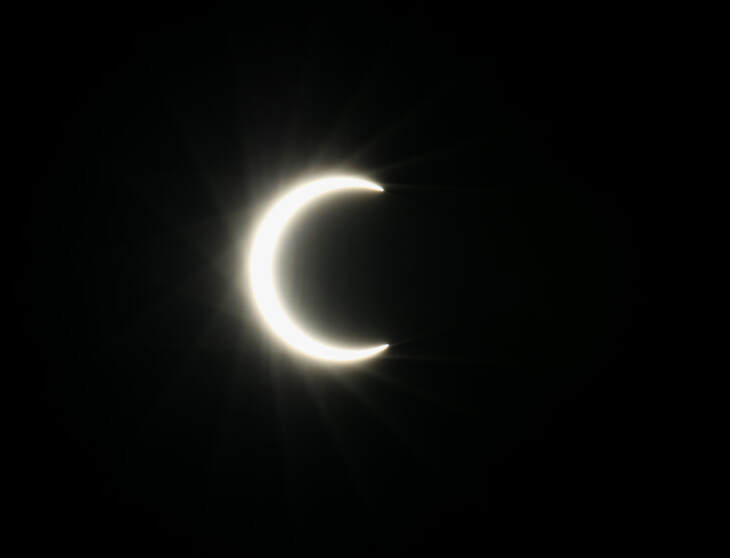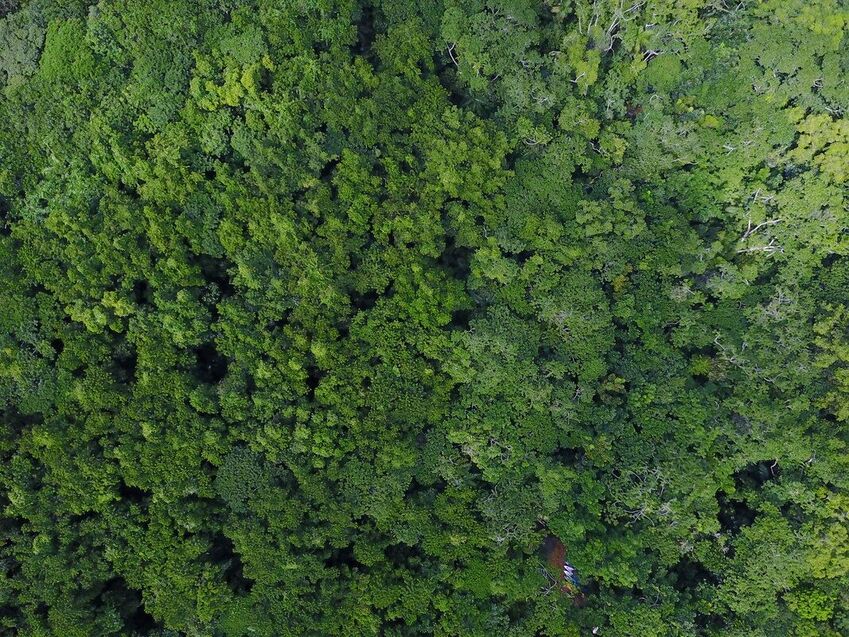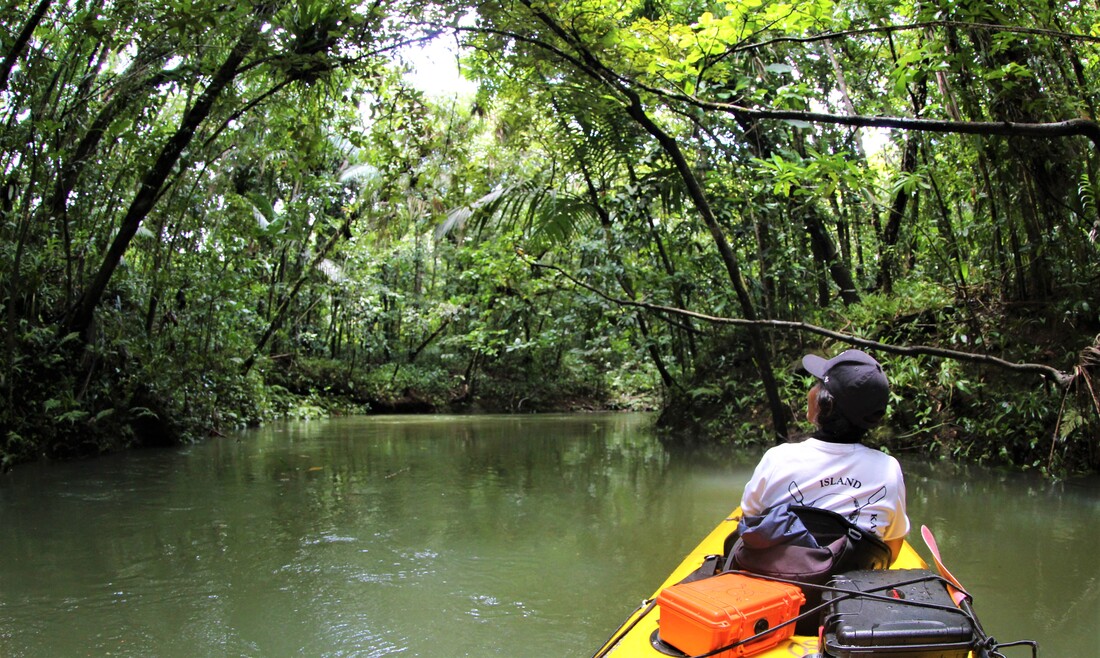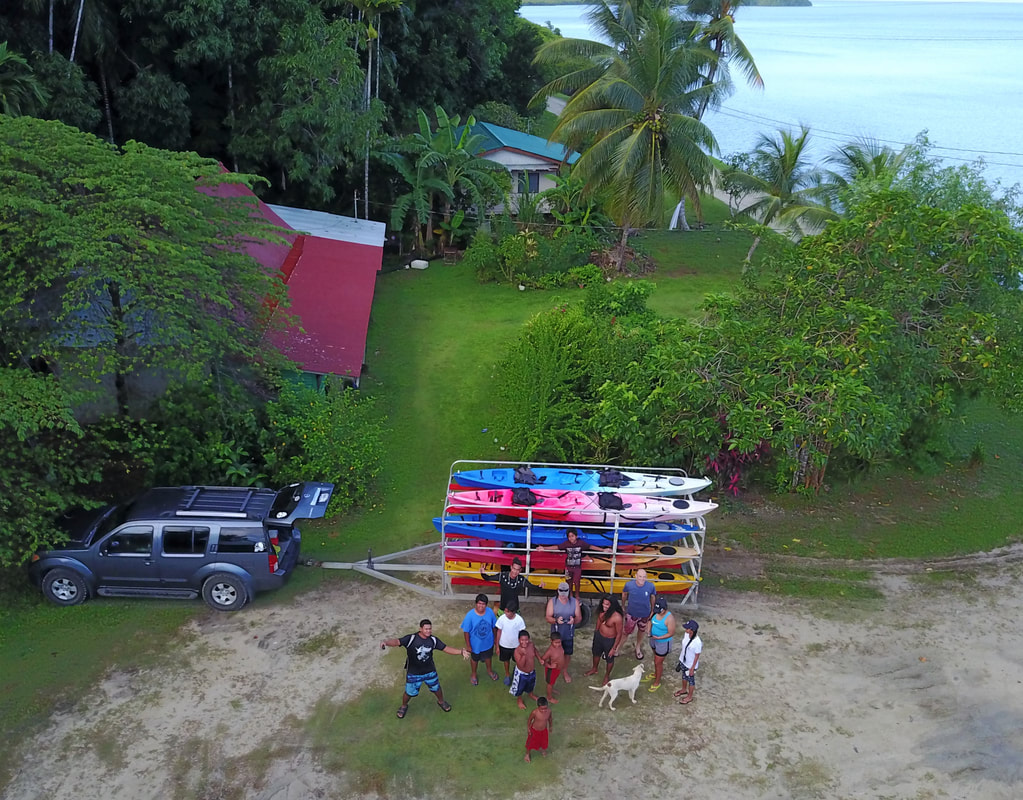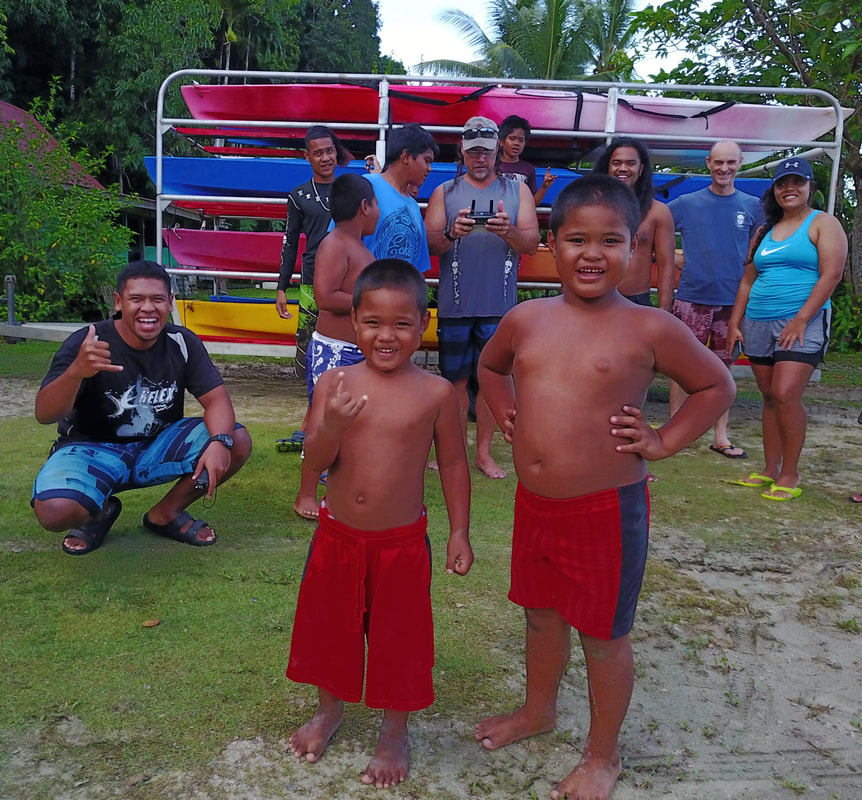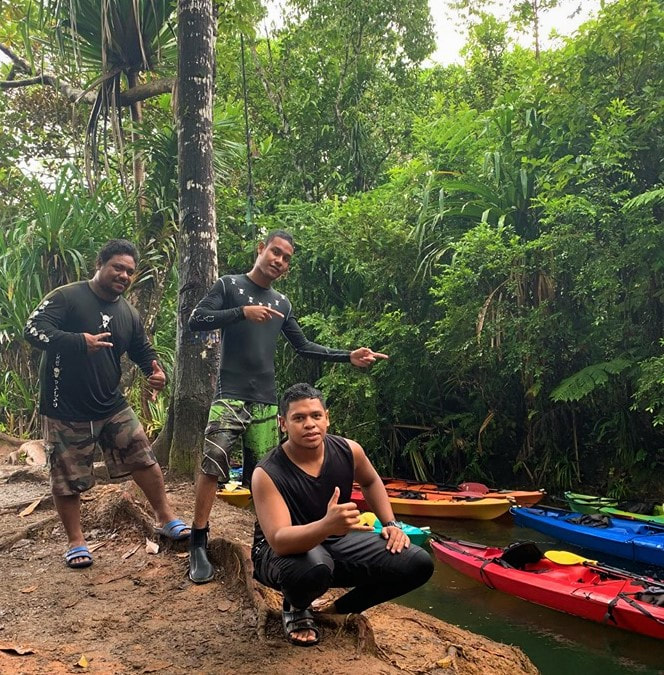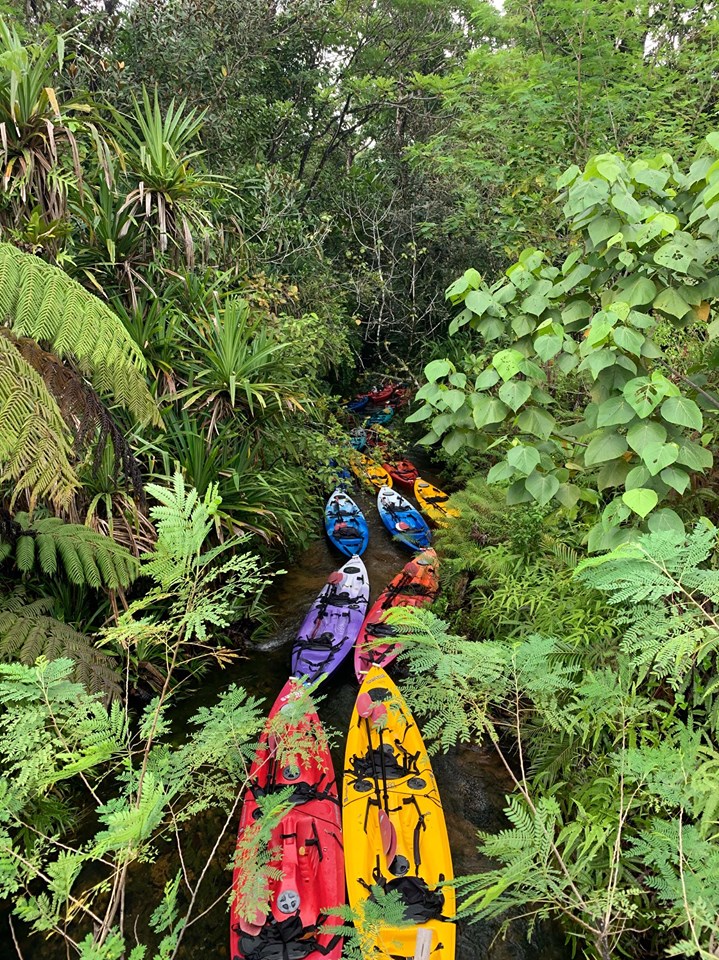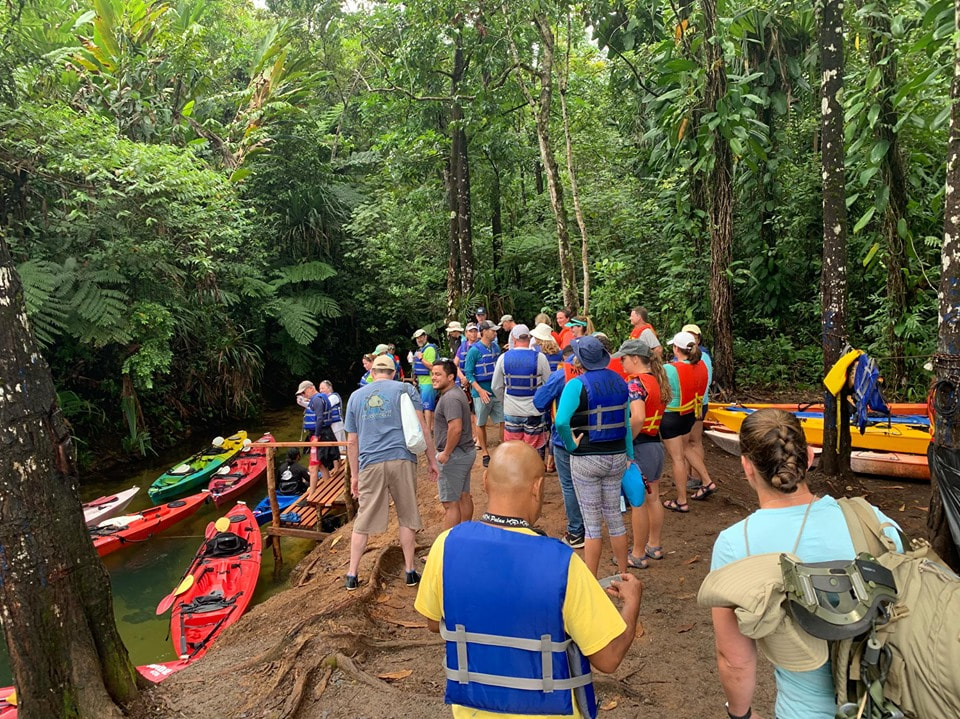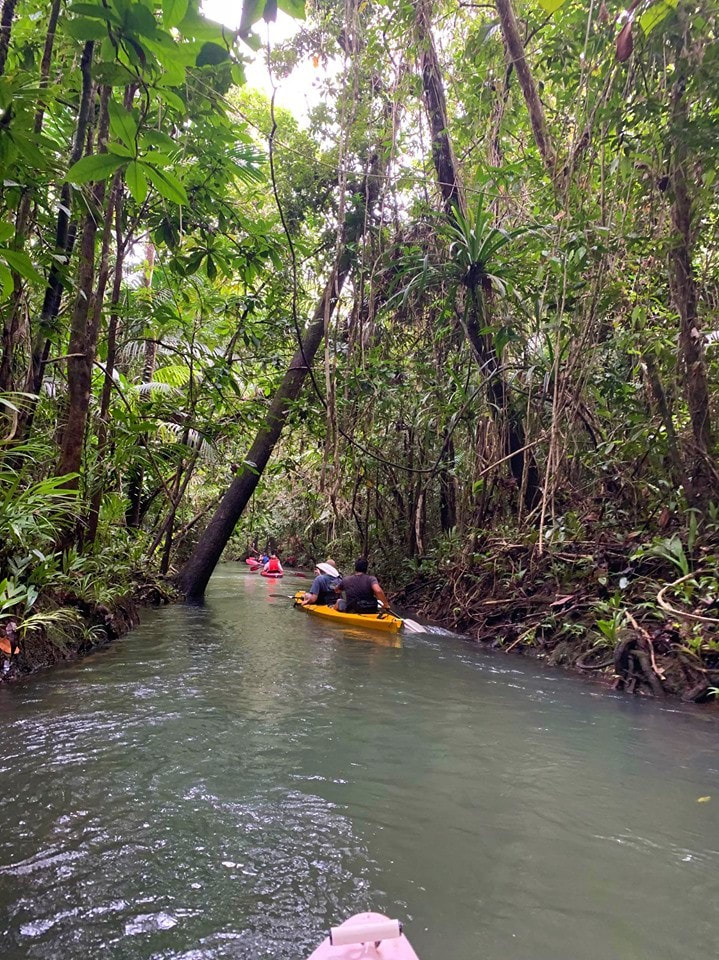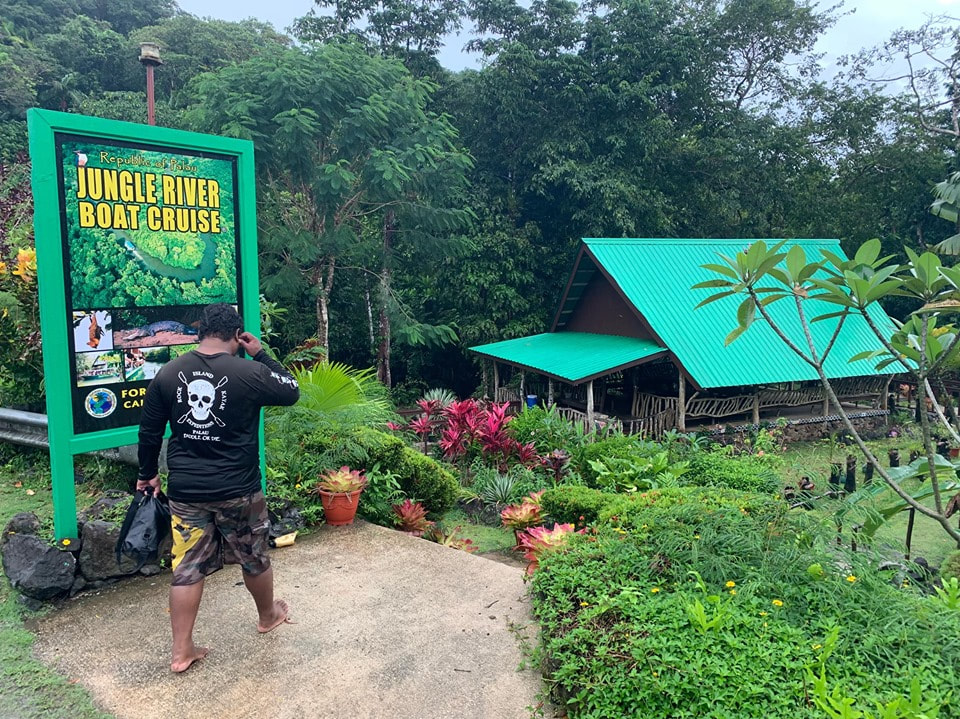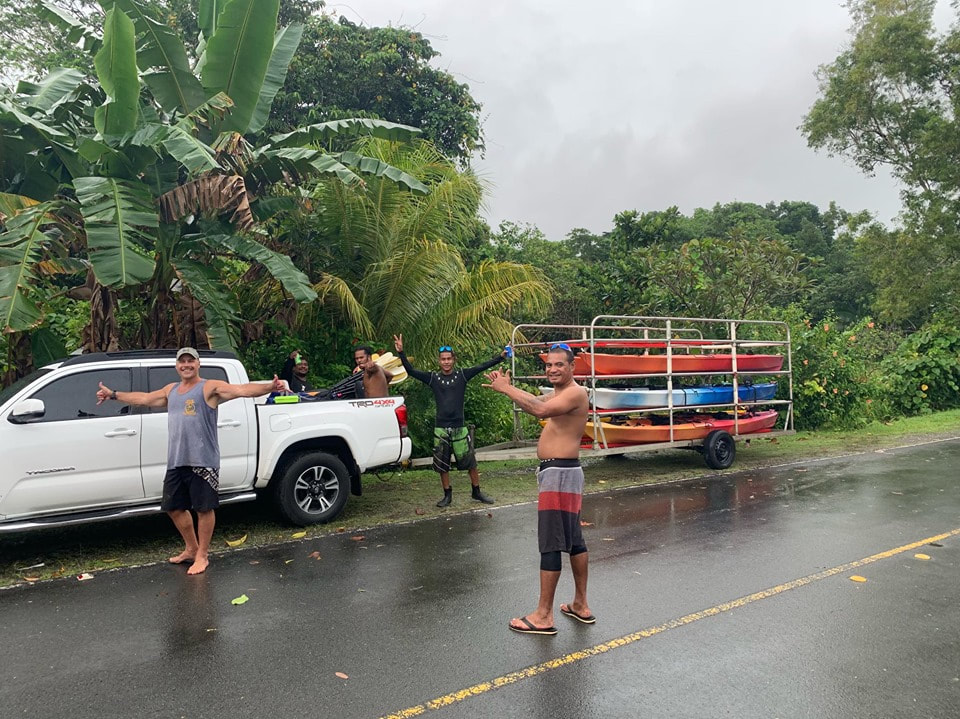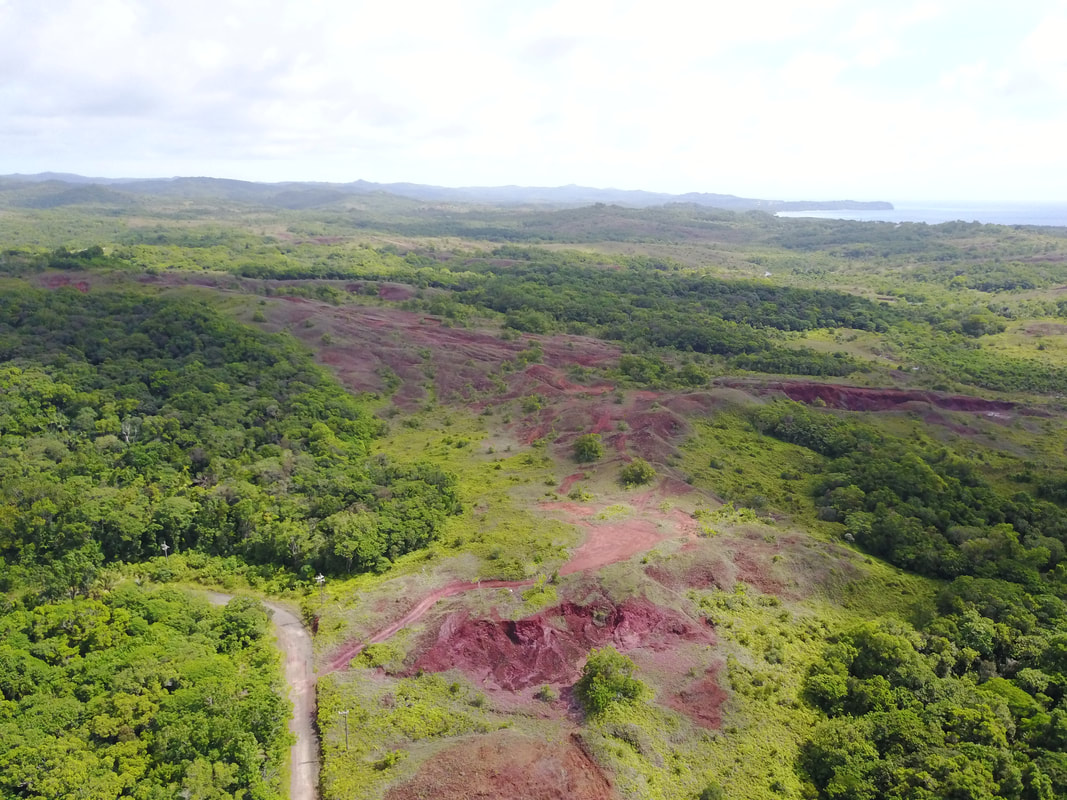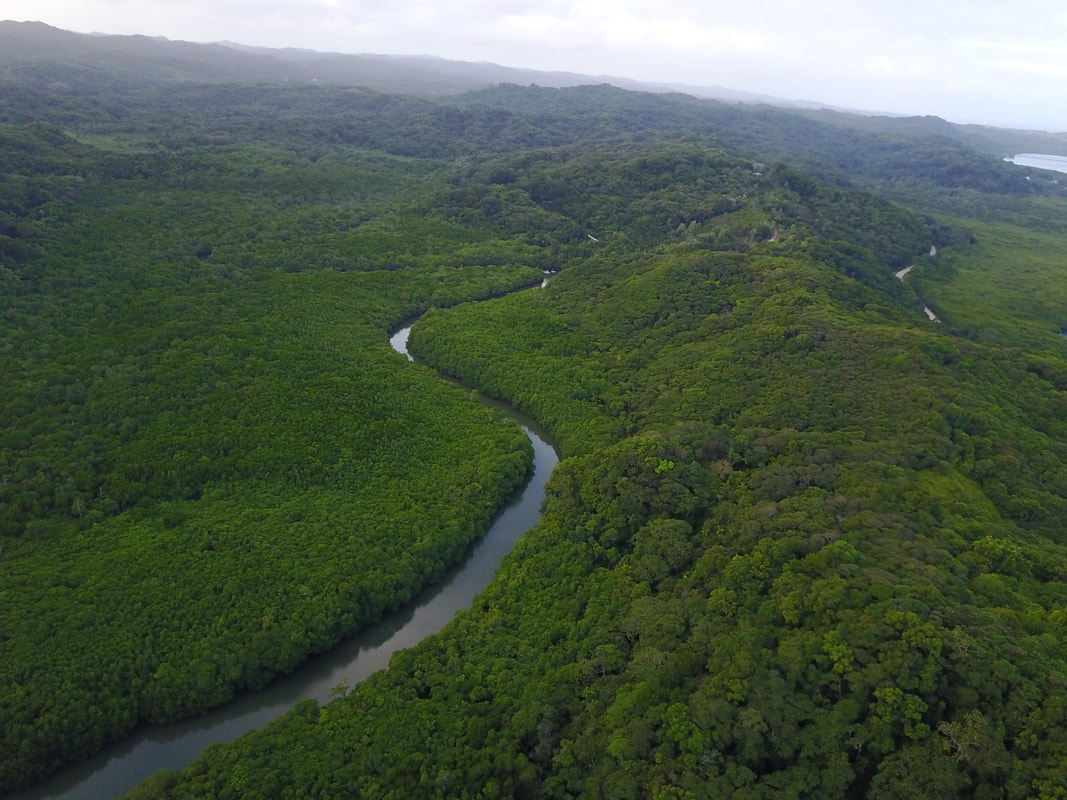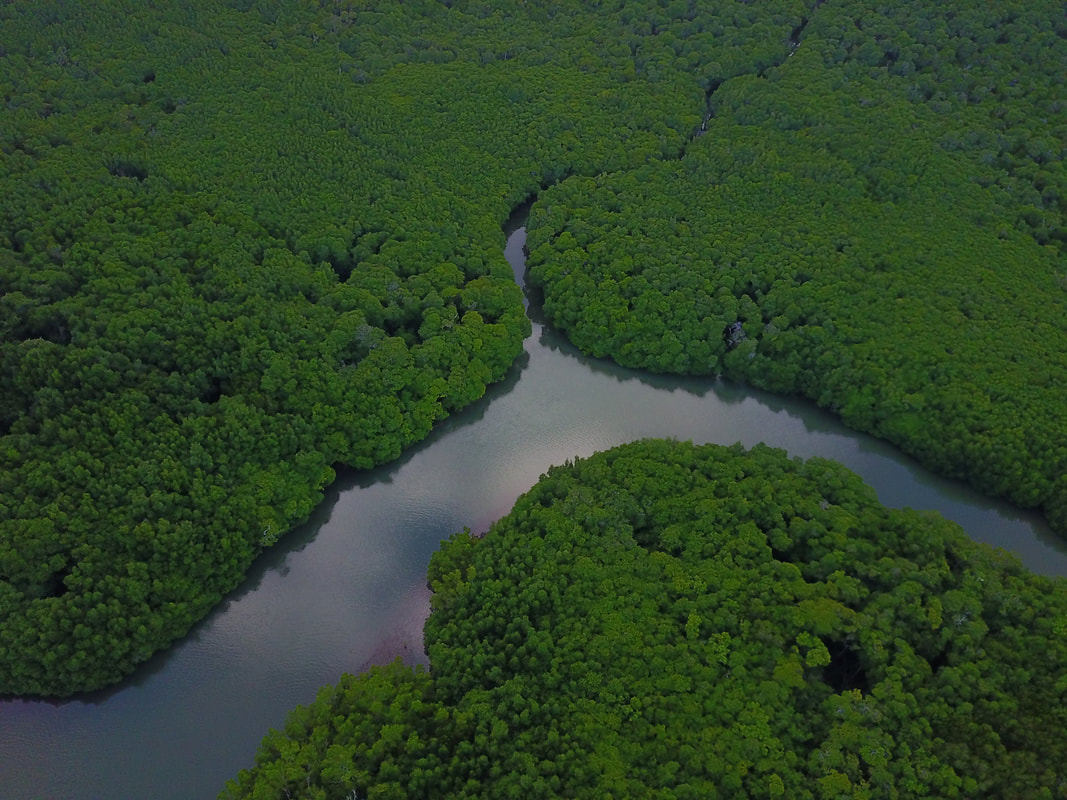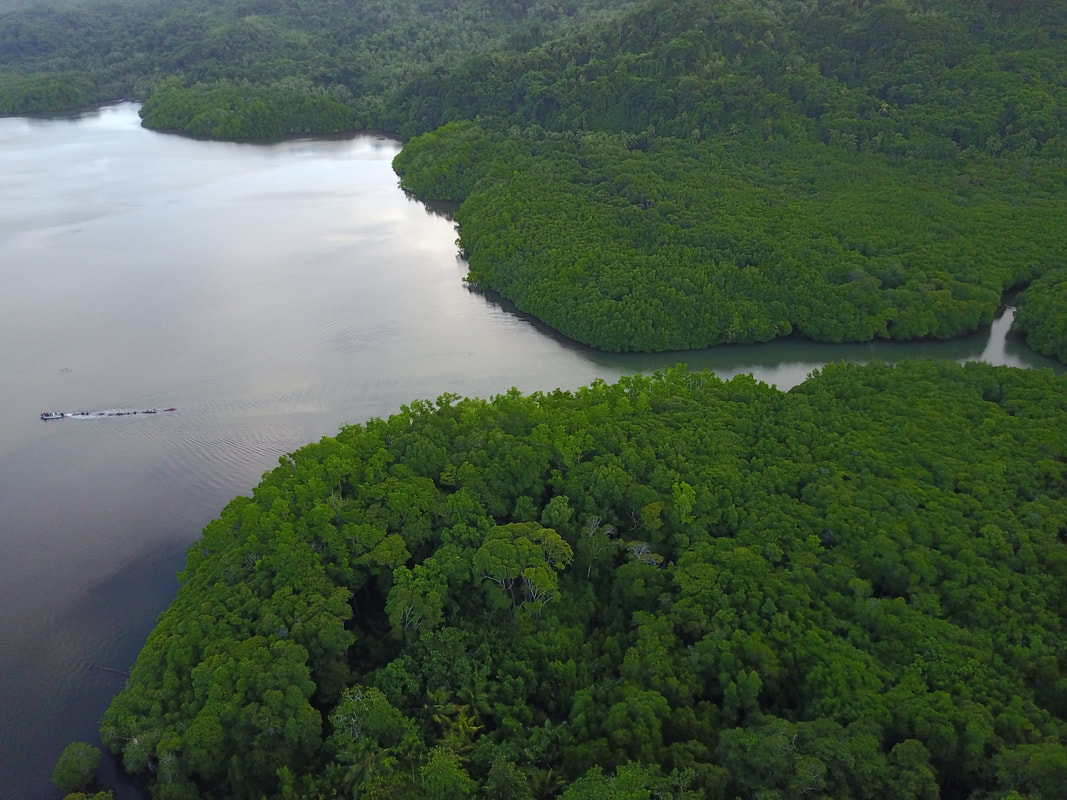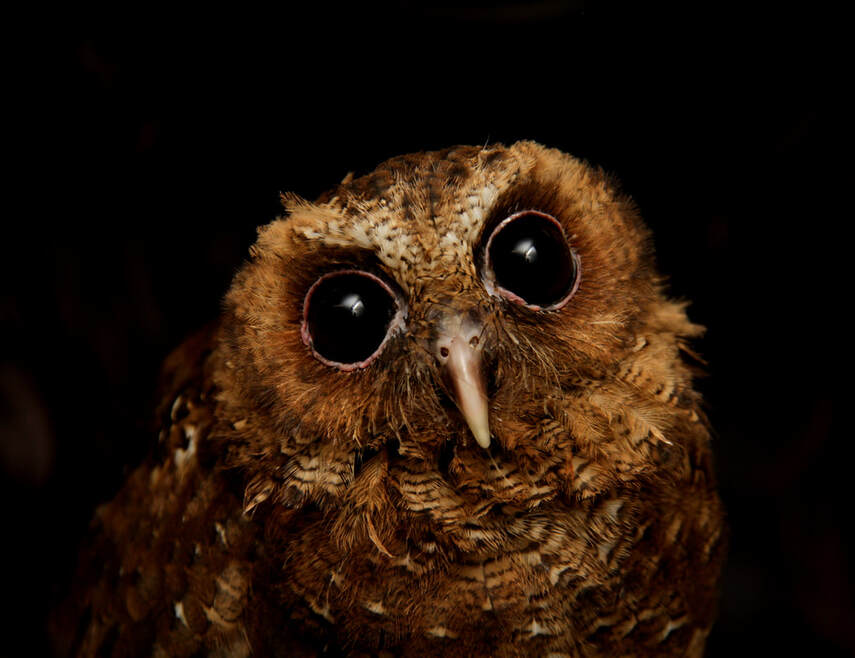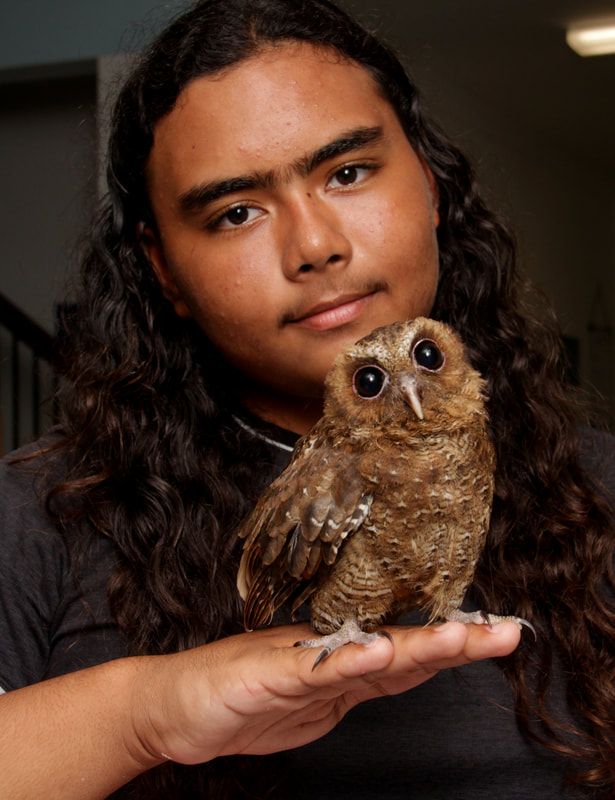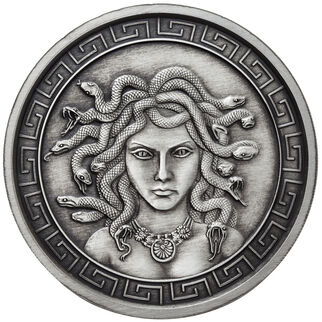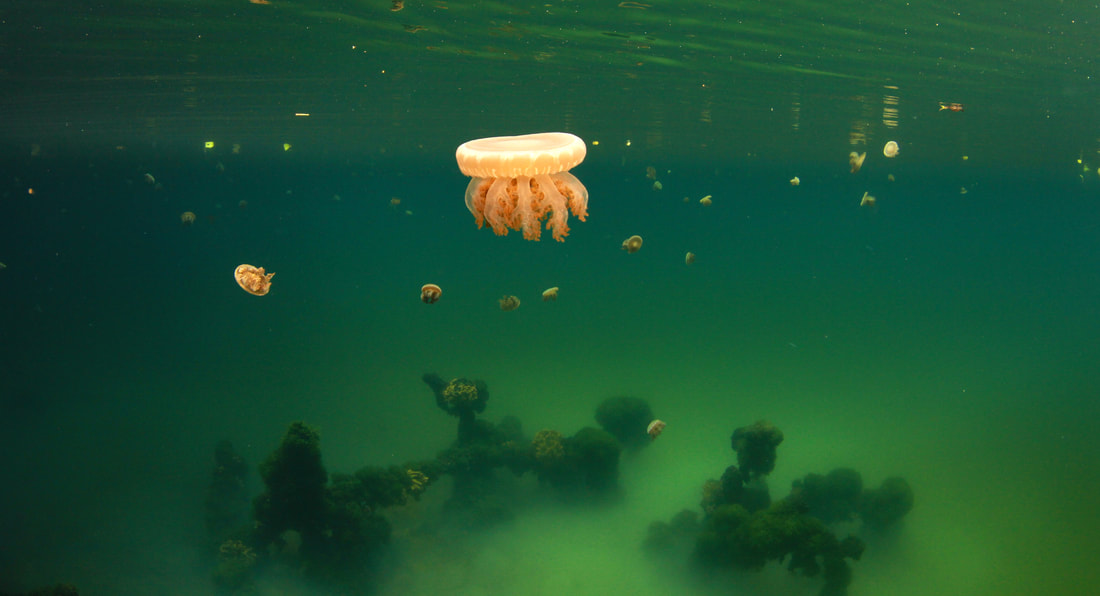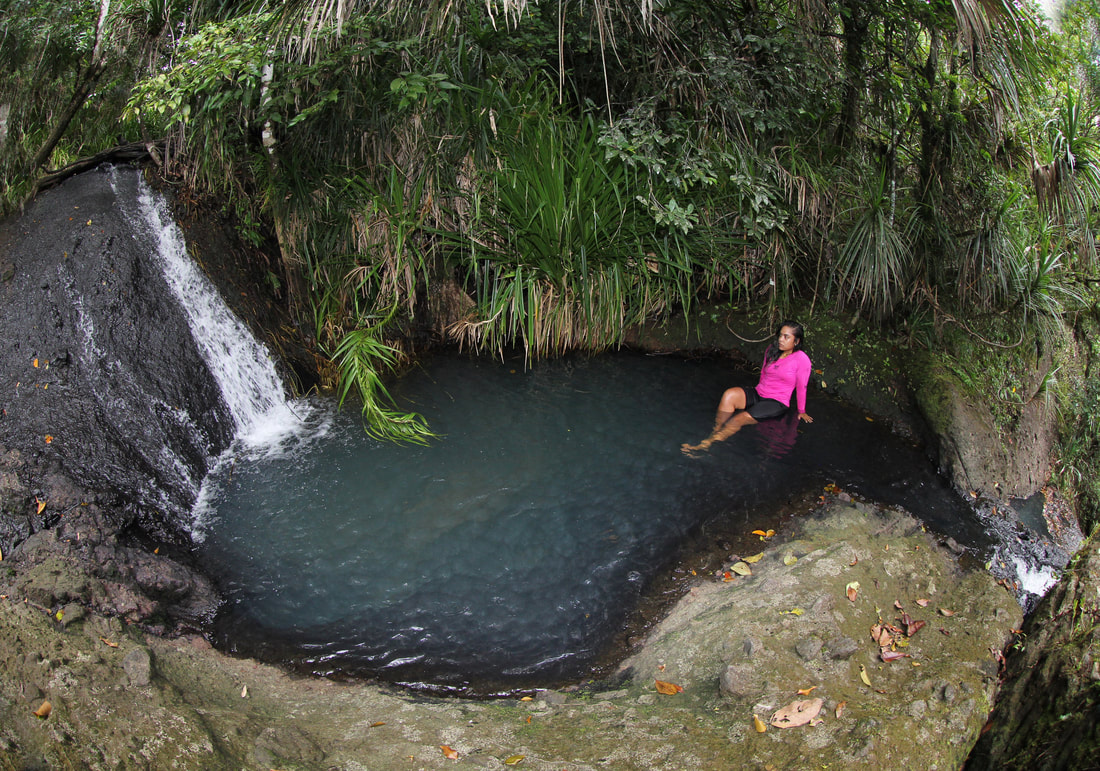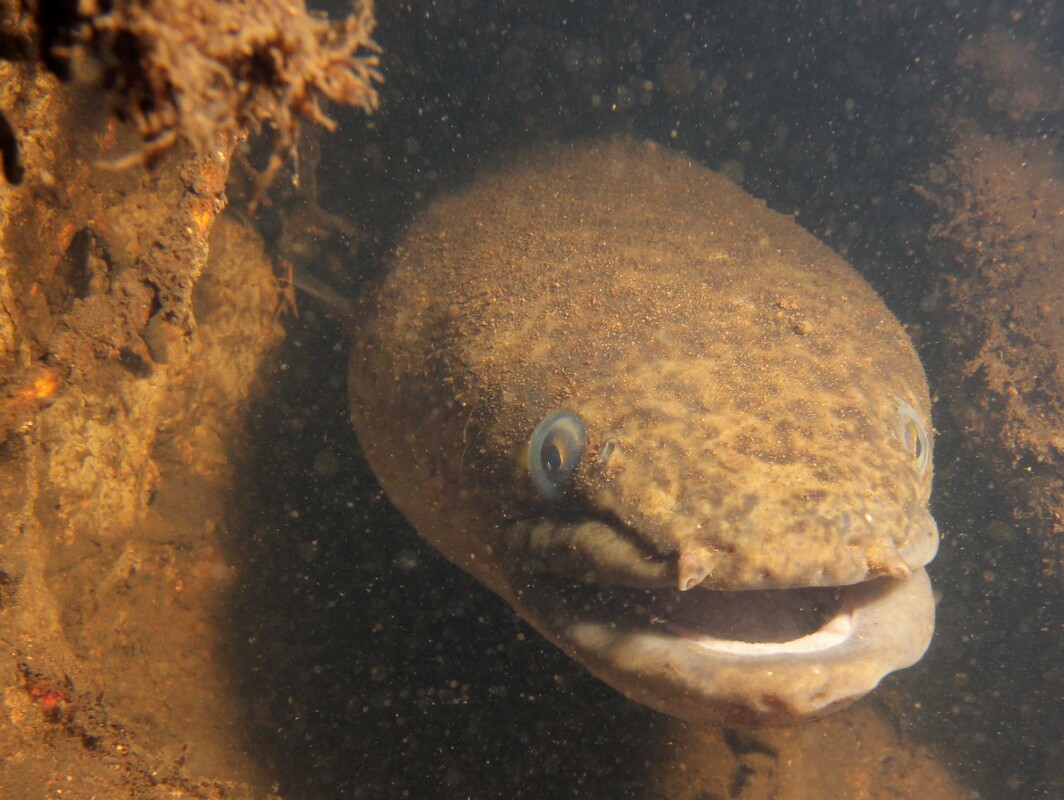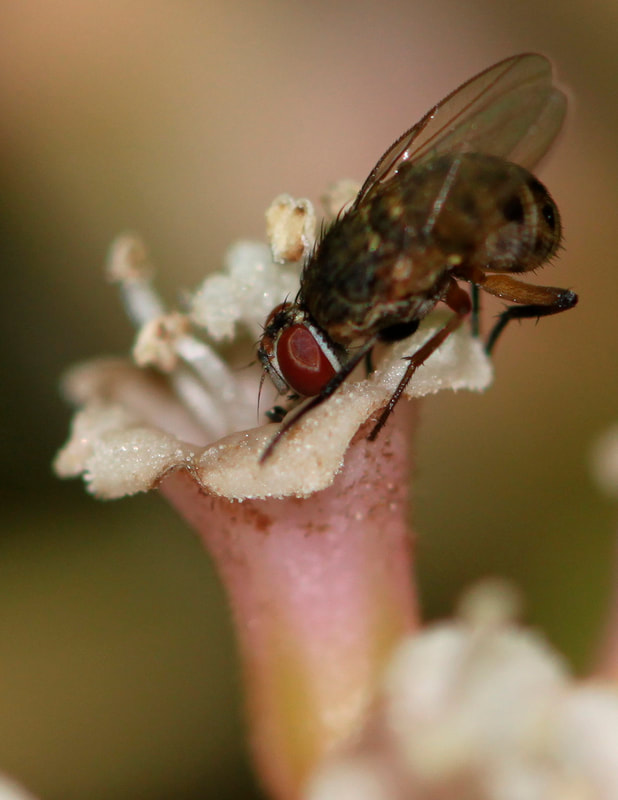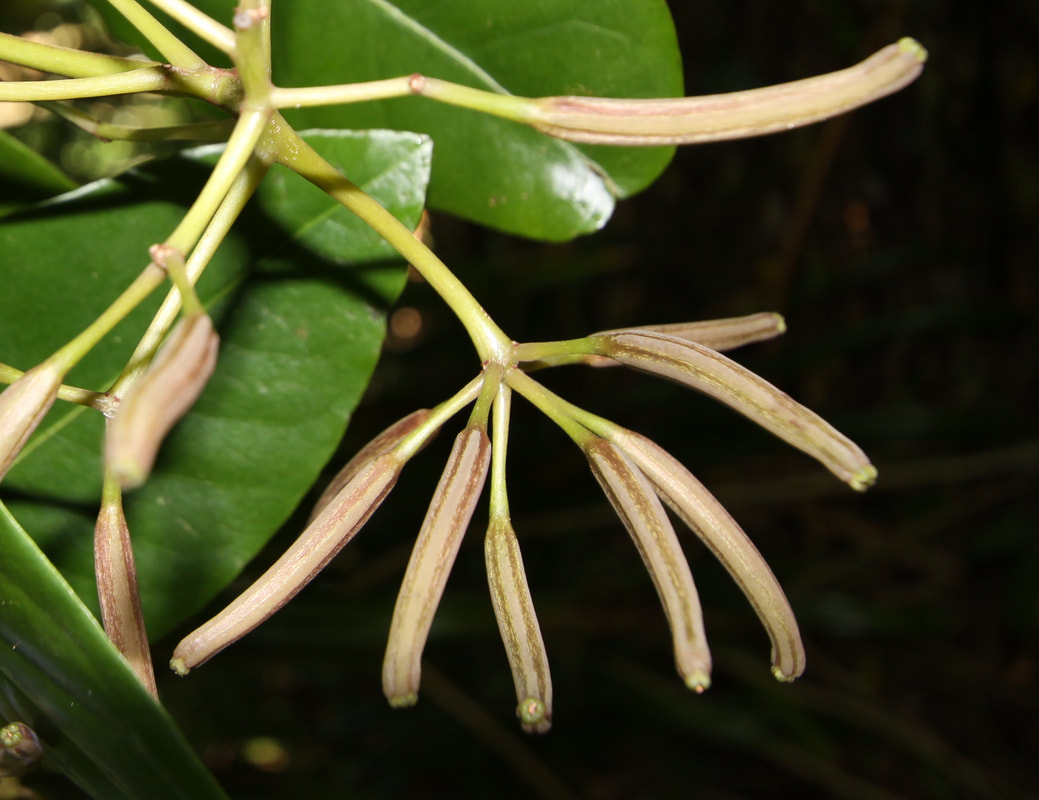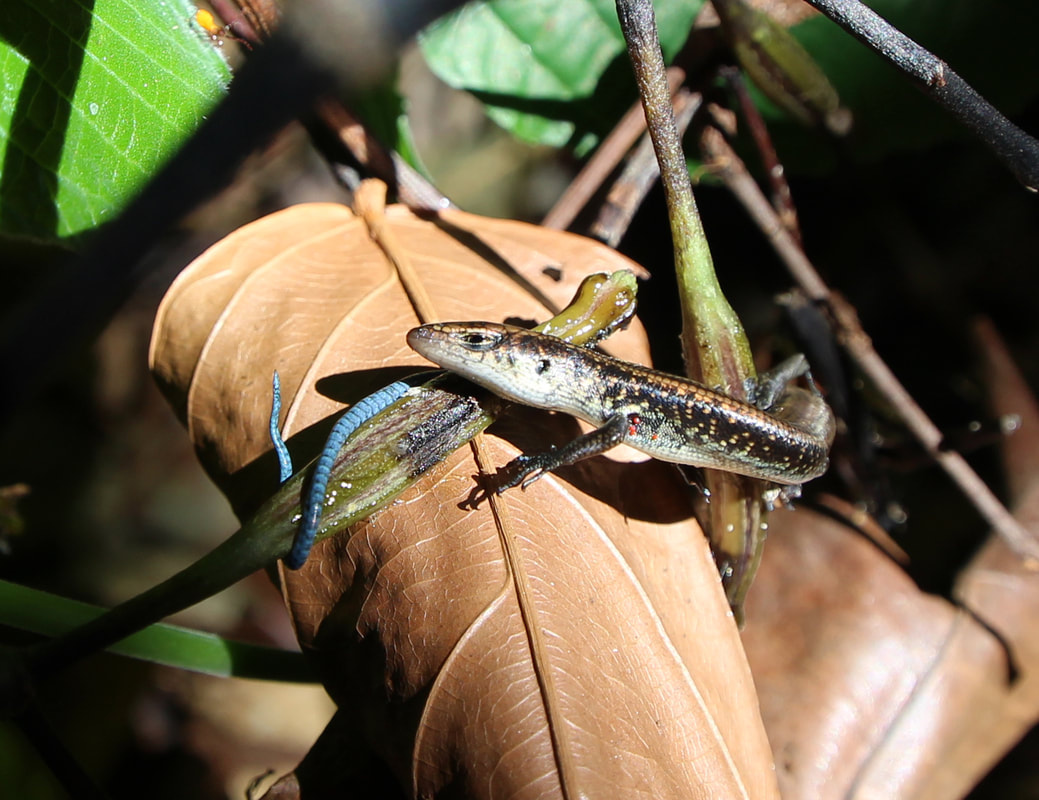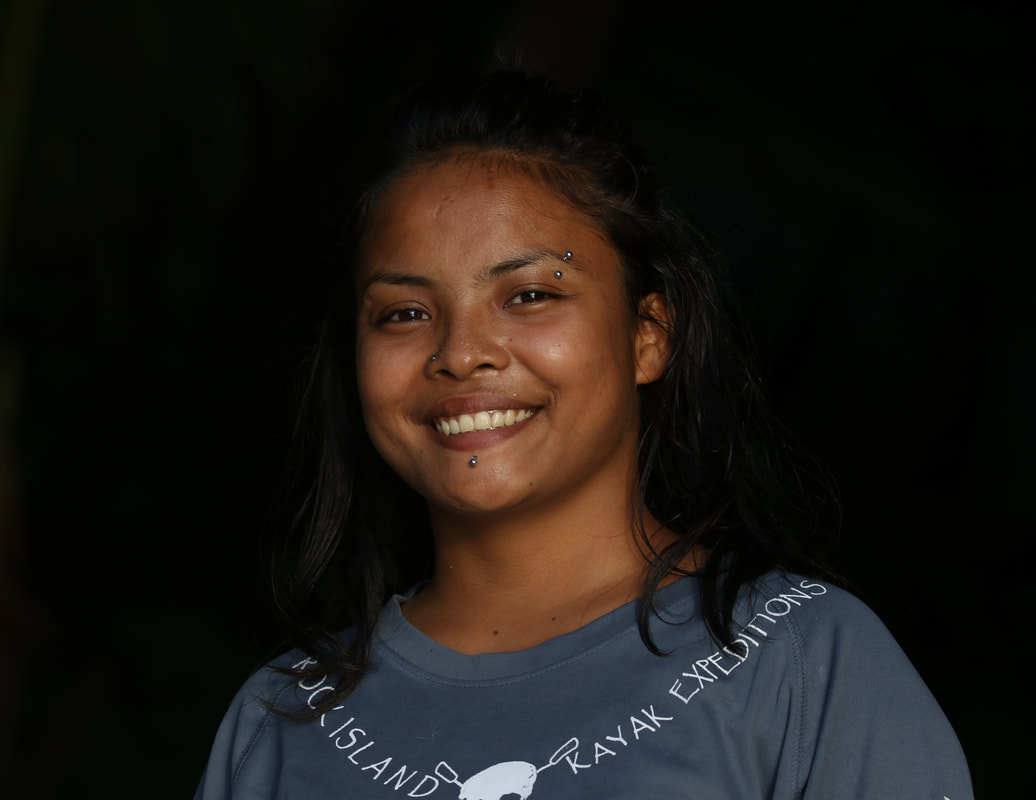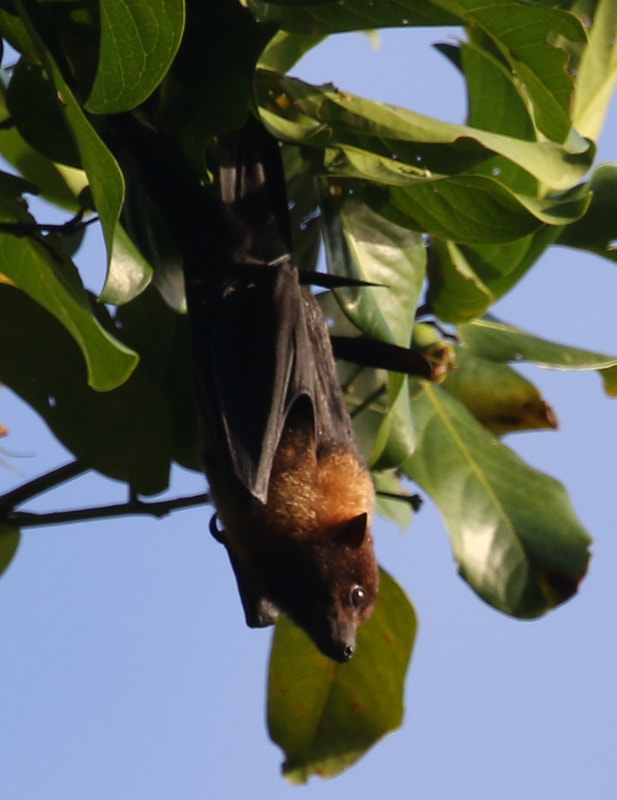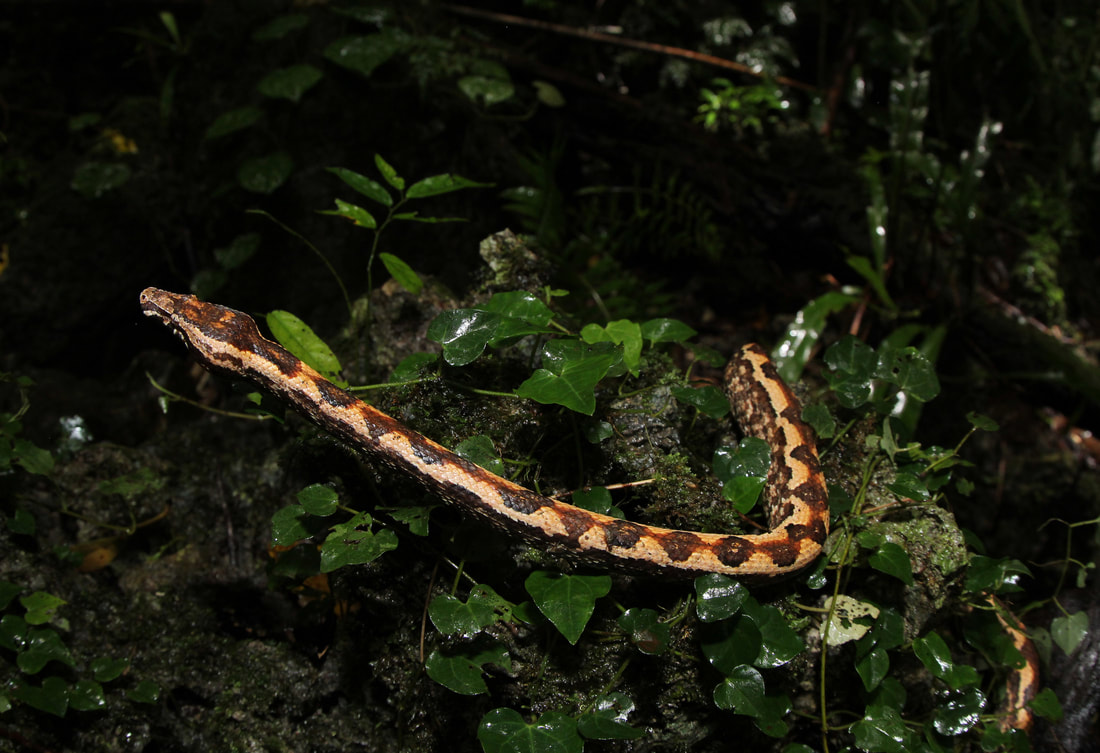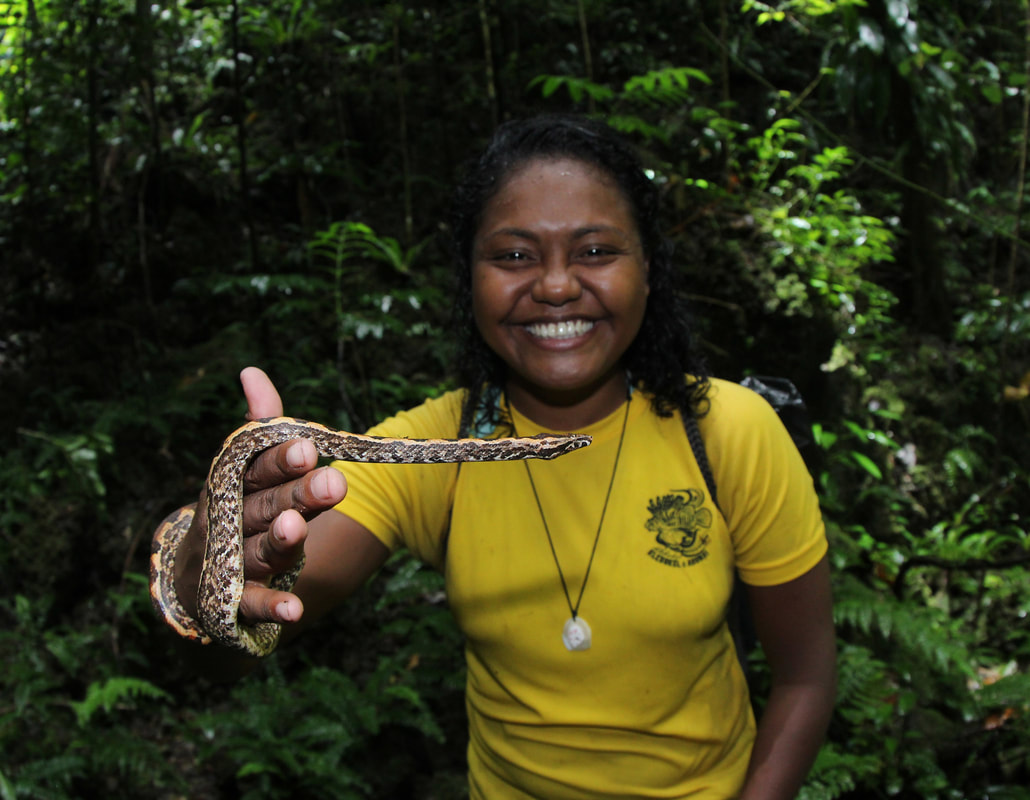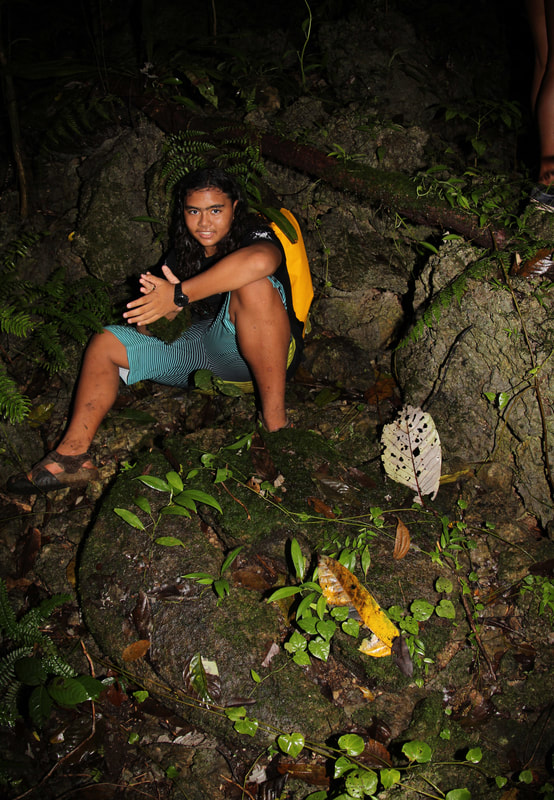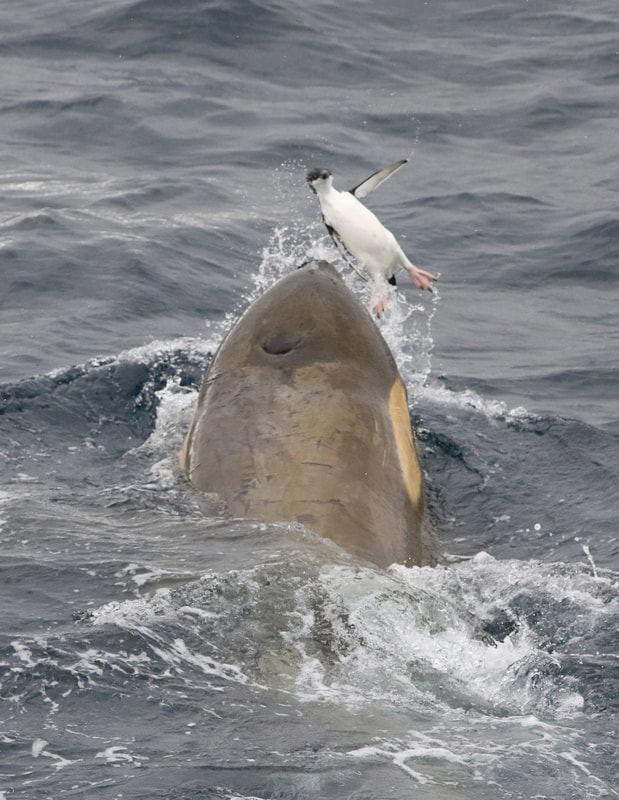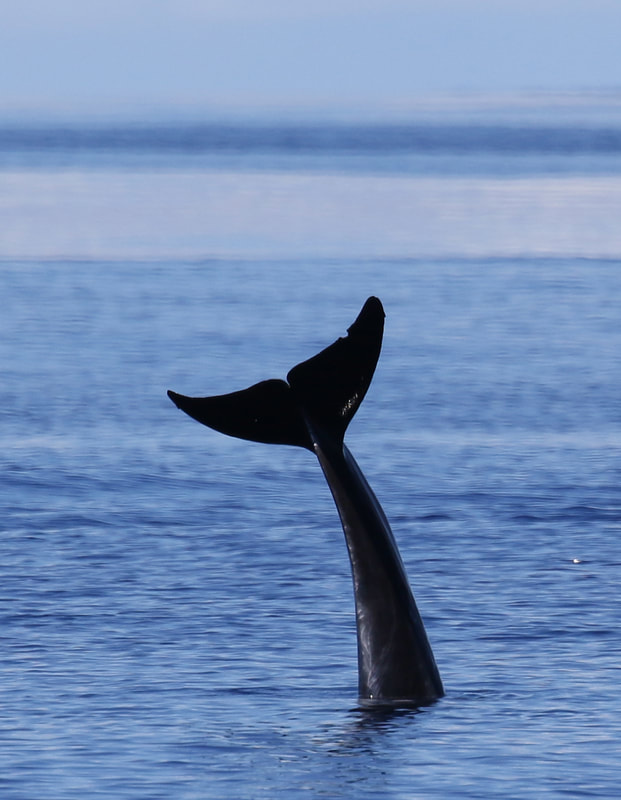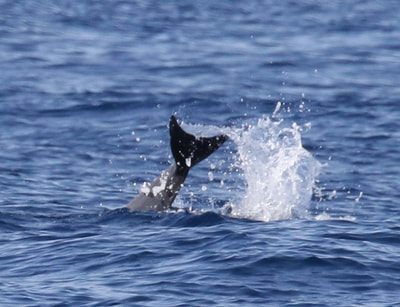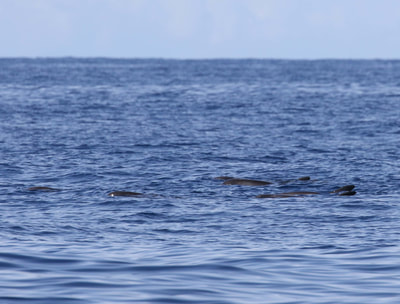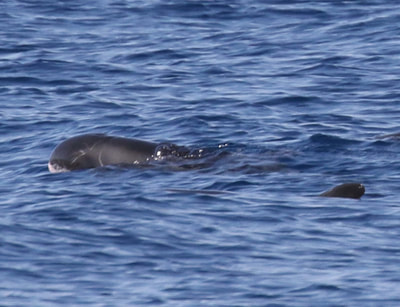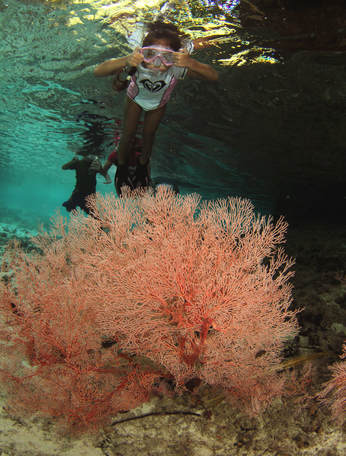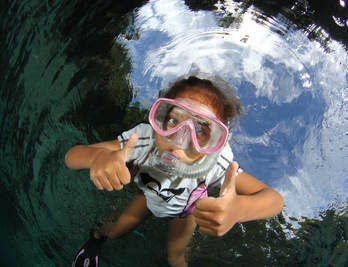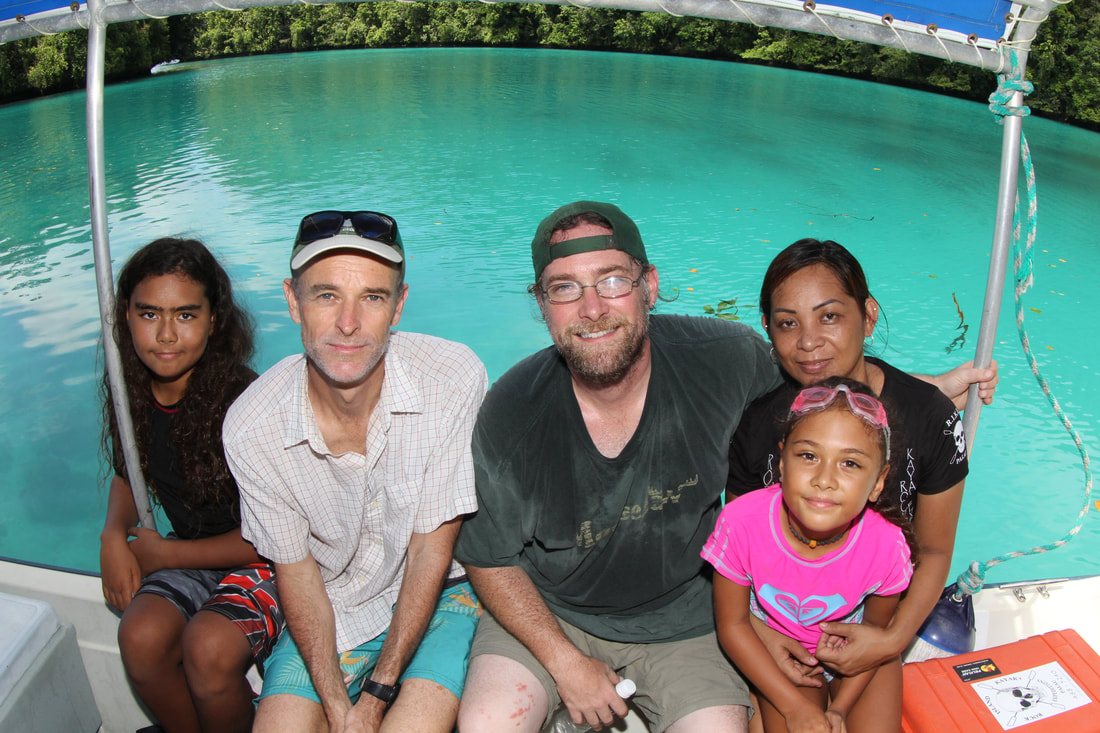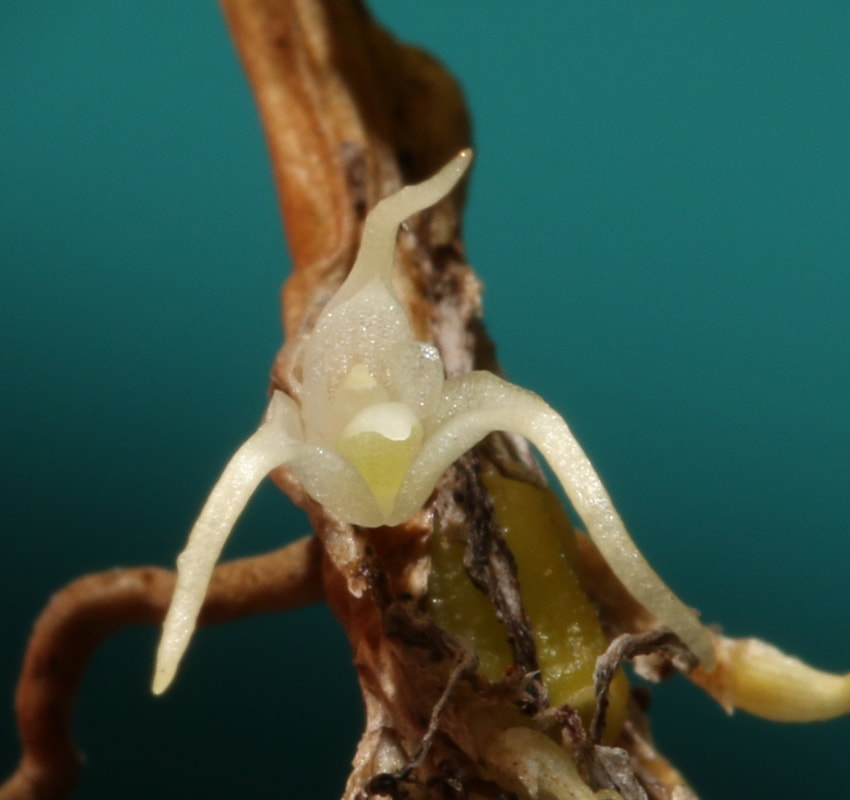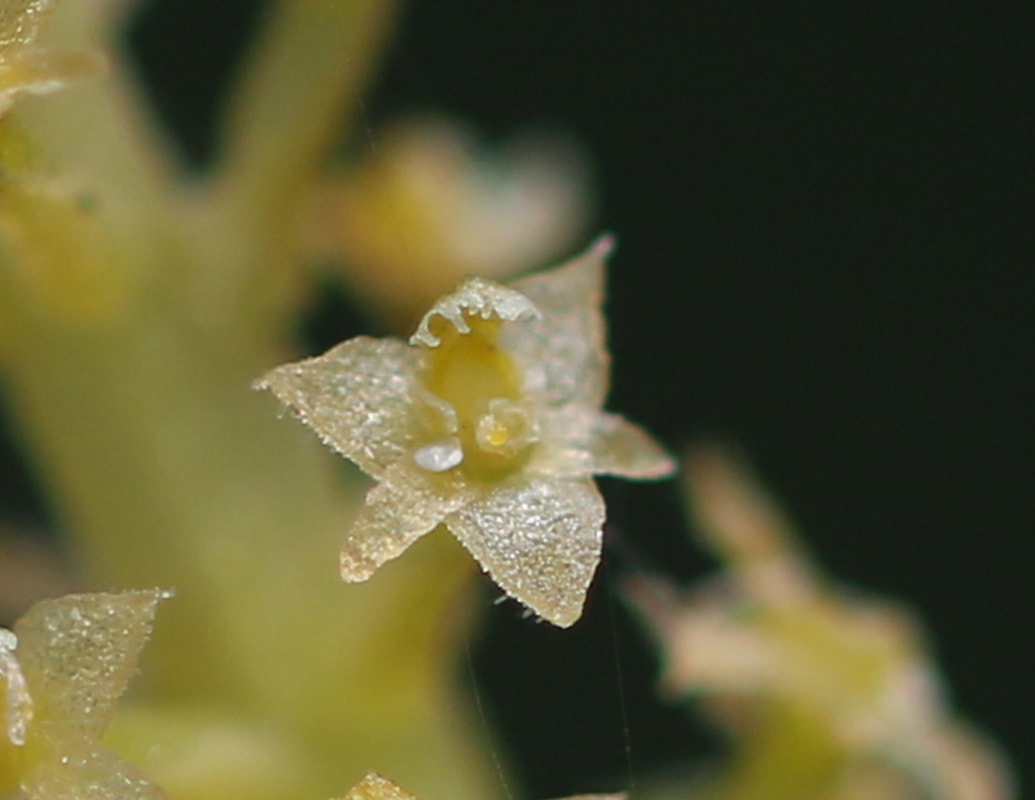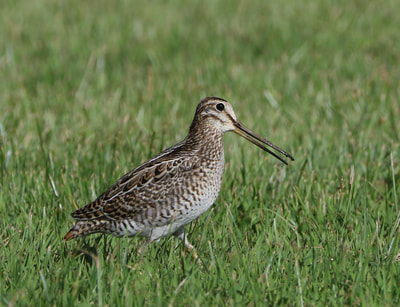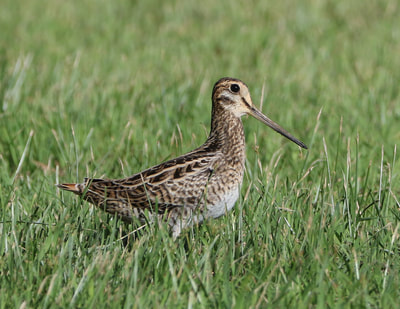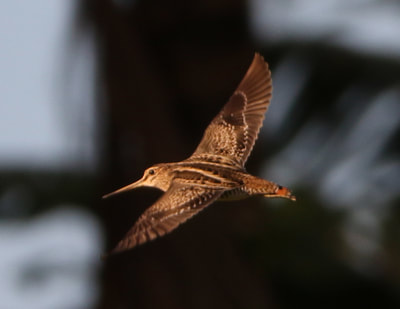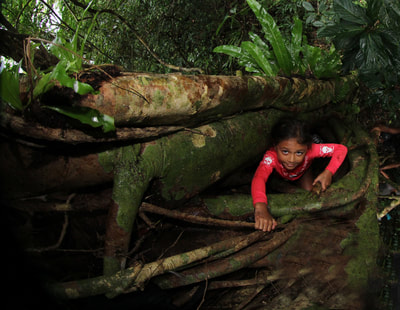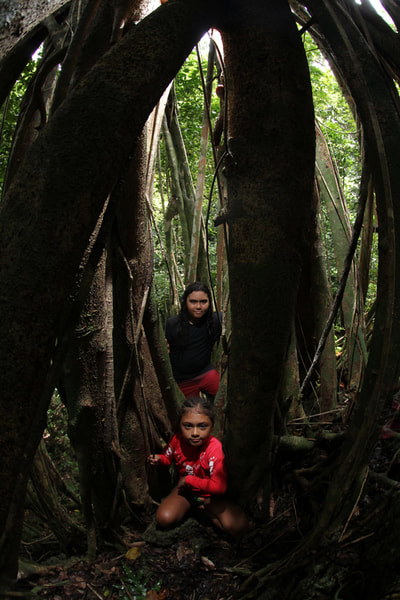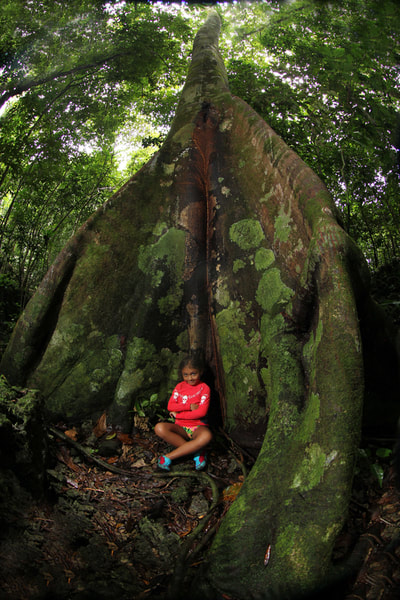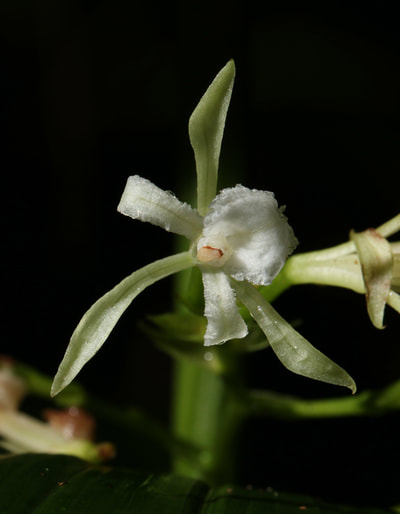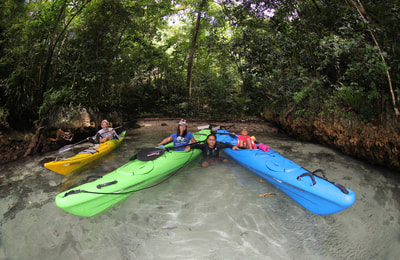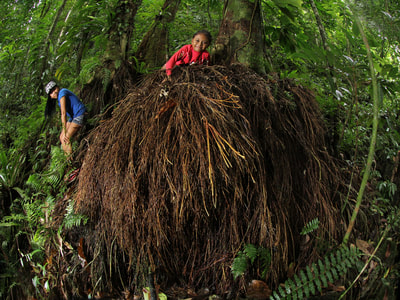Usually when we hear single celled, we think of microscopic building blocks of life that can't be perceived with the naked eye.
This widespread algae species can withstand low light, appearing in tidal zones of tropical and subtropical areas across the globe.
Upon first sight of these beautiful glass spheres, you might think you've hit the jackpot. Their unusual bright reflective sheen makes them appear like giant pearls. They can be found in a variety of shades of green from bright emerald to dark moss. They can appear silver, teal or black in the water. Sometimes the sea pearls are covered with a thin layer of lavendar colored algae.
The alga forms large, thin walled elliptical sacs. The round sacs are single cells and can grow to 5 cm in diameter, among the largest known.
So how does something with a single cell grow so large? The bubble alga only has one cell, but that cell contains parts of multiple cells. This is known as coenocytic organisms. They have many cell nuclei but are not separated by cell walls. This allows the species to grow to macroscopic size and visible enough for us to see.
Because of this makeup, there is invasive potential. If you were to pop one, you'll end up with many more. As with all marine life, simply enjoying the beauty of it all is the best practice.
By EliLai Sugiyama
]]> Most folks don't associate Sea Gulls with tropical habitats. The nutrient poor waters of most equatorial environments simply don't produce enough nutrients & biomass to support these heavy bodied sea birds. Thus, Palau lacks breeding populations of the Sea Gulls, found on the temperate shores of Australasia.
That being said, Palau is still lucky enough to receive a small flock of Black Headed Gulls during our winter months. Escaping the frigid temperatures of Northern Asia, these majestic sea birds endure the long-distance flight across perilous stretches of Ocean to reach our Pacific paradise. As the Gulls have been habituated to fishing boats, they can be most commonly encountered around the islands Malakal and Peleliu.
The scientific name for the Black Headed Gull is Chroicocephalus ridibundus. The genus name is a Greek translation of khroizo, which means "to colour", and kephale, "head". This is in reference to the fact that the breeding plumage produces an attractive Black Cap on the head. The species name ridibundus is a Latin translation of ridere, which means "laughing." The gulls are normally quiet when approached, but will make a wonderful laughing call when the mood strikes them.
These foreign visitors have flown a long way to share our waters, so let's remember to treat them with kindness and respect. We're very lucky to have these beautiful additions to our seasonal biodiversity.
These foreign visitors have flown a long way to share our waters, so let's remember to treat them with kindness and respect. We're very lucky to have these beautiful additions to our seasonal biodiversity.
By: Ron Leidich
]]> Having evolved Branchiostegal Lungs, the coconut crabs are free to move about on land, having largely severed their ties with the sea. In fact, if these massive Crustaceans are immersed in water for too long, they can drown. Even mating occurs on dry land. Ultimately the females return to the edge of the sea to release their eggs, hoping to have them dispersed with the tides and currents.
The adult crabs have a rapacious appetite and will consume everything from fruit to sea birds. They've been known to sneak into the nest of Frigate Birds & Boobies at night and subdue their prey, earning them the knick name "Robber Crabs." True to their vernacular, they're also able to husk and consume coconuts. When needed they can even climb to the top of the palms to dislodge their meal, before shredding the husk to get to the nutritious meat.
Once fully matured, the Coconut Crabs are virtually immune to predation, save for a few exceptions. The salt water crocodile, even on land, remains a formidable predator and can easily consume coconut crabs. Historically, the greatest menace to the coconut crab was the fully terrestrial crocodilian, Mekosuchus. These bizarre reptiles ranged from Australia to Vanuatu and New Caledonia and only disappeared recently with the arrival of man. Mekosuchus could even climb trees in pursuit of their prey!
The biggest threat to Coconut Crab health and happiness today is human predation. Considered a delicacy throughout their range, the giant Crustaceans have been extirpated on many of the more populated islands of Oceania. Fortunately, in Palau, there are hundreds of uninhabited limestone islands, where the crabs can enjoy a free and easy lifestyle.
The biggest threat to Coconut Crab health and happiness today is human predation. Considered a delicacy throughout their range, the giant Crustaceans have been extirpated on many of the more populated islands of Oceania. Fortunately, in Palau, there are hundreds of uninhabited limestone islands, where the crabs can enjoy a free and easy lifestyle.
By: Ron Leidich
]]> - Cobi Jones
By: Cobi Jones
]]> The Republic of Palau is blessed with over 70 salt water lakes, trapped inside the limestone islands. Each of these lakes rises and falls with the tides due to the porous nature of the surrounding rock. As the tide rises, salt water rushes through minute openings allowing each lake to "breathe" with the incoming tide. Over geologic time, these tiny pours increase in size, leading to the formation of macro-tunnels. Under normal circumstances, these tunnels deliver oxygenated water, nutrients, and even the larva of corals, fish, and marine invertebrates. Thus the tunnels serve as The Breath of Life for these otherwise trapped salt water environments.
Sadly, with the introduction of the global plague of plastics and marine debris, the tunnel systems can become clogged up. This can have grievous effects on the marine life living inside the lakes, denying them food, oxygen, and nutrients. Thus it's more than appropriate to occasionally lend the lakes a helping hand.
Sadly, with the introduction of the global plague of plastics and marine debris, the tunnel systems can become clogged up. This can have grievous effects on the marine life living inside the lakes, denying them food, oxygen, and nutrients. Thus it's more than appropriate to occasionally lend the lakes a helping hand.
On World Ocean's Day, 2020, the father & son team of Ron & Calvin Leidich slipped away from their docks and raced to the nearby Blue Bottle Lake.
Squeezing into the constricted tunnel system on Scuba, the diving duo began removing the anthropogenic obstacles, which included plastic buoys, discarded shoes, abandoned fishing line, and even WWII truck tires!
After removing the impediments the divers ventured into the lake to say hello to the resident fish life. They were immediately surrounded by the diamond shaped Monodactylus fish and enjoyed encounters with the impeccably shy juvenile Giant Sweet Lips.
The fish had no way of acknowledging the diver's good deed for the day, but the brief encounter was a subtle thank you for the job well done.
]]>The Paddling Palau team has been patiently waiting all season for the seas to calm down. On Saturday May 23 our wish was granted. With winds of only 5-10 knots, we're finally able to access the open ocean in search of dolphins, whales, and other big game.
After 30 minutes of playtime with a pod of our resident Spinner Dolphins, we continued a few miles further out to sea. Boat Captain Dustin Blesam spotted driftwood so we raced over to check out the action. As expected, the floating log served as a FAD (fish aggregation device). The shade, algae, & barnacles provide ample food and protection for a host of pelagic fish. The team jumped in with cameras and Go Pros to record these elusive oceanic wanderers. We were immediately greeted by juvenile Oceanic Triggerfish which swam right up to our lenses for a closer look.
Schools of predatory Wahoo remained enticingly just out of range of our cameras, circling us, out of sheer curiosity. To our delight they were accompanied by 2-3 foot Silky Shark pups. These open ocean sharks have been decimated for decades, as the Palau government allowed foreign fishing fleets to wipe out our high seas resources. As of January 1, 2020, that situation has improved somewhat. Having declared Palau a marine sanctuary, all of the Long Line Tuna vessels departed Palau's exclusive economic zone. Sadly, Palau continues to allow purse sein vessels from Okinawa to fish inside the marine sanctuary under a dubious bilateral agreement with Japan.
The beneficiaries of the Commercial Long Line Vessel departure includes the Silky Sharks as they have been historically targeted for their valuable fins. Without the threat of capture, the Silkies are now increasing in number and size. The presence of the pups is an especially positive sign as it indicates successful breeding and recruitment. Unlike their wary reef shark cousins, the Silky Sharks show no fear of people and will approach somewhat disconcertingly within touching range. Despite their menacing appearance, the Silky Sharks can be discouraged with nothing more than eye contact, leading to some especially exiting encounters.
After sharing some good times with the Silky Sharks we continued further out to sea, where we bumped into the migratory Spotted Dolphins. A pod of several hundred dolphins raced towards our boat as if they'd seen a long lost friend. After showing off their jumping prowess, the cetaceans disappeared into the depths in search of their scaly prey.
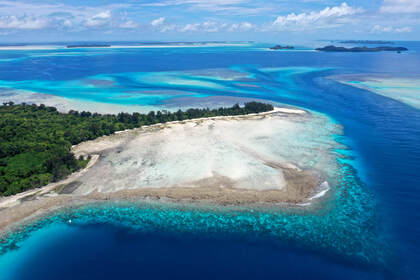
We finished our day at the Ngerchong Inside dive site, for Kendra Miluu Leidich's 16th dive. Schools of Soldier Fish & Bream hovered over a mountain of Cobblestone Coral. We climbed back on board the boat for a one hour ride back home with memories of leaping dolphins and swirling sharks dancing in our heads.
We finished our day at the Ngerchong Inside dive site, for Kendra Miluu Leidich's 16th dive. Schools of Soldier Fish & Bream hovered over a mountain of Cobblestone Coral. We climbed back on board the boat for a one hour ride back home with memories of leaping dolphins and swirling sharks dancing in our heads.
By: Ron Leidich
]]>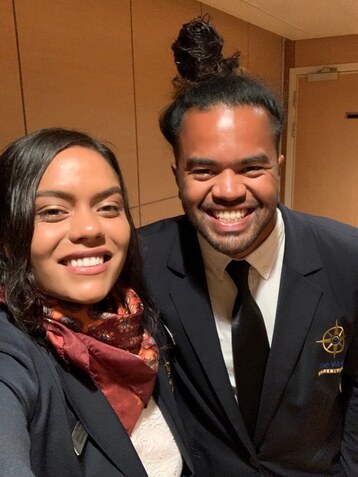
On January 13, 2020 Palau received a visit from a unique expedition ship called "The World." While most cruise ships and expedition vessels embark passengers and guests, The World carries only residents. Everyone onboard other than staff is an owner of a cabin or stateroom. The residents travel around the planet in the luxurious setting of a beautiful ship, complete with ballrooms, bars, and fine dining restaurants. The residents explore the very best of earth's dive sites, wildlife destinations, and cultural wonders. Their non-stop tour of the planet includes annual visits to The North West Passage, Antarctica and everywhere in between.
This journey to Palau marks The World's second visit to our Micronesian paradise. Most of the residents agreed that sites like Blue Corner & Turtle Cove were among the very best tropical dive sites on the planet. The residents have the freedom to vote on where The World travels each year, and the opinion was nearly unanimous that Palau had to be seen a second time around.
This journey to Palau marks The World's second visit to our Micronesian paradise. Most of the residents agreed that sites like Blue Corner & Turtle Cove were among the very best tropical dive sites on the planet. The residents have the freedom to vote on where The World travels each year, and the opinion was nearly unanimous that Palau had to be seen a second time around.
In addition to a full staff of engineers, seamen, waiters, and attendants, The World also hires an expert team of Naturalists during phases of their voyage known as "Expedition." The naturalists are hired by a European based yacht service known as EYOS. EYOS seeks out the very best marine biologists, ornithologists, geologists, and historians, in order to teach the residents on board about the habitats and cultures they encounter. The naturalists travel with the residents for three to four week voyages, leading tours, and giving lectures in the spacious auditorium. These specialists come from all walks of life and typically include university professors, authors, and academics.
This year's visit to Palau however marks a turning point in The Worlds choice of experts. For the first time ever, expert Palauan Naturalists have joined the EYOS team for the voyage from Palau to Darwin, Australia. Veteran guides Macstyl Sasao and EliLai Sugiyama were carefully chosen by EYOS to share their knowledge of the region's bio-fauna, history, and culture. The pair will explore the remote corners of Western Papua to include the famous four kingdoms, known in Bahasa as Raja Ampat. They'll continue through the Moluccas, of Spice Island fame before traveling on to Australia's most Northerly city. Macstyl will lead kayak tours and will offer lectures on the region's plants, animals, and history, while EliLai leads the snorkelers with talks on fish, corals, whales, dolphins, & culture.
From an economic standpoint, this implies that Palau's guides have become so esteemed internationally, that they are now a valued export commodity. Few people outside of Micronesia have an in depth understanding of the region's biodiversity, history, or cultures. It's taken Macstyl & EliLai years of study and training to achieve this level of status. The fruits of their labors have now led them to a career that will literally take them "around the world." We'll all be looking forward to hearing about what they've learned from this most recent experience to the remote corners of Asia-Pacific.
]]>| The first stop on the journey was Fantasy Lake which is physically protected from winds and waves by the spiraling limestone walls surrounding the deep watered bay. Boat Captain Udoud Masaharu made the first discovery of the day, which proved to be rather monumental. Udoud had spotted tiny pink flowers born on vertical spikes covering a previously unrecognized tree. Despite the combined decades of experience among the Paddling Palau naturalists, no one on board could identify this precious set of flowers. | |
That didn't stop photographer Oby Roland from setting up her macro kit to take advantage of the moment. Oby set up her camera on a gimbal mounted tripod, while her assistants secured the flowers in an equally stable position. With microscopic precision Oby focused on the minute blooms and lit the tiny flowers from a multitude of angles. Meanwhile, veteran guide Macstyl Sasao took careful aim with his 100-400mm telephoto lens and photographed the fruits and seeds from the same tree.
The team continued on and explored a nearby lake in search of flowers from an endemic understory specialists called Discocalyx palauensis. Though this small shrub thrives in the shaded canopy of the limestone forest, it tends to bloom only when exposed to the soft light along the shores of the salt water lakes. After a hike over some rather horrendous limestone peaks, the team found its second prize of the day. The minute flowers of Discocalyx were in full bloom, allowing the photographers to add another species to their floral catalog.
The team continued on and explored a nearby lake in search of flowers from an endemic understory specialists called Discocalyx palauensis. Though this small shrub thrives in the shaded canopy of the limestone forest, it tends to bloom only when exposed to the soft light along the shores of the salt water lakes. After a hike over some rather horrendous limestone peaks, the team found its second prize of the day. The minute flowers of Discocalyx were in full bloom, allowing the photographers to add another species to their floral catalog.
Upon returning the shop, the naturalists poured through their library of Botany books as well as their archived images. Udoud & Oby's mystery flowers were unlike anything they'd seen and they were unable to identify the species. Ultimately they turned to the master of Pacific Botanists for some helpful advice. Dr. Art Whistler is the author of over a dozen books on the Botanical assemblages of the Pacific Islands. Some of his most popular titles include "Flowers of the Pacific Island Seashore" & "Plants of the Canoe People." Art had no trouble in determining the identity of this new flower as he mentally scrolled through his Botanical keys. The species in question proved to be another reclusive endemic known as Elattostachys palauensis of the family Sapindaceae.
The Paddling Palau team have now photographed nearly 200 species of flowering plants in the limestone islands and look forward to someday publishing a book titled, "Flowering Plants & Pollinators of Palau." Following up on that theme, Udoud & naturalist Ron Leidich raced back out to the scene the day after Christmas to inspect their prize specimen tree. Not only was the tree still in bloom, but it had additionally attracted a host of tiny moth pollinators. It's taken nearly 20 years of Botanizing to compile photos of these excessively rare species, and yet the islands continue to reveal more of her secrets. While most visitors flock to Palau to enjoy her under water treasures, many of the best kept biodiversity secrets remain hidden in the limestone forests.
]]>The Paddling Palau team have now photographed nearly 200 species of flowering plants in the limestone islands and look forward to someday publishing a book titled, "Flowering Plants & Pollinators of Palau." Following up on that theme, Udoud & naturalist Ron Leidich raced back out to the scene the day after Christmas to inspect their prize specimen tree. Not only was the tree still in bloom, but it had additionally attracted a host of tiny moth pollinators. It's taken nearly 20 years of Botanizing to compile photos of these excessively rare species, and yet the islands continue to reveal more of her secrets. While most visitors flock to Palau to enjoy her under water treasures, many of the best kept biodiversity secrets remain hidden in the limestone forests.
The females carefully choose their nesting sites to maximize the protection of her young. With outstretched arms, the mother cuttlefish delicately reached out to place her white eggs inside the branches of a stinging fire coral, Millepora sp. The fire coral is actually a colony of stinging hydroids with a hard calcareous skeleton, much like their true coral cousins. Predators are unwilling to brave the stinging cells (cnidoblasts) of the colony, and thus the embryonic cuttlefish have a safe haven to start their life.
| The female was initially wary of the free diving intruders, though she quickly habituated and began to focus on her important task. Meanwhile her mate was spotted nearby by tour leader, Macstyl Sasao. The male Cuttlefish was more defensive and raised a pair of arms, signaling his annoyance at the intrusion. The male remained vigilant, standing guard of his female lest a predator or rival male move into his territory. Upon hatching the juvenile cuttlefish will recruit to the myriad bays and lagoons of Palau's inner reef system. The youngsters will then hone their predatory skills, targeting small fish like gobies and blennies. With lightning speed the cuttlefish extend their arms and trap their prey in the grip of their suction cups. The strike occurs so quickly that one is usually left with only the evidence of glittering fish scales scattered in the wake. The Cephalopods are the Invertebrate Zenith in terms of intelligence. Young cuttlefish will quickly learn to follow snorkelers over the reef. As the fish are distracted by the presence of the floating hominids, the super Mollusks take advantage of their clueless prey. It's not uncommon for the baby cuttlefish to become so habituated as to allow a snorkeler to gently hold them in their hand! By: Ron Leidich |
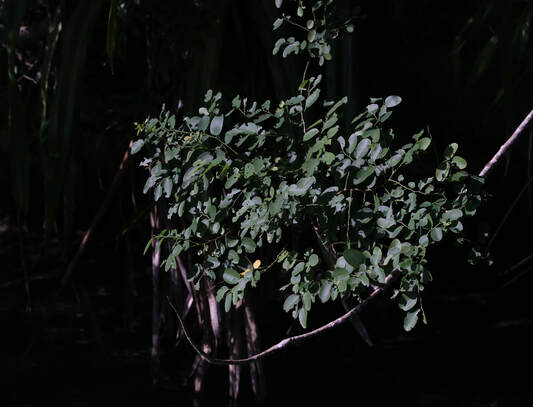
While out Botanizing with boat captain Udoud Masaharu on December 26, 2019, I was setting up for a shot of Dalbergia oligophylla in the soft afternoon light. Rather mysteriously, the golden light took on a bluish tinge, ruining my otherwise well composed image. I looked over my shoulder to check the cloud cover and was surprised to find clear blue skies overhead.
Udoud excitedly announced "it's a solar eclipse, not the clouds!" I countered that it was just a misty haze and that it would soon pass. Rule #1: Never contradict anyone who tracks social media because they are in my opinion all knowing and all telling. Of course Udoud was correct. The new moon was in almost perfect alignment to block the light of the sun. Fortunately, we were well equipped to capture the moment with a telephoto lens mounted on a Canon 7DMarkII. I pushed the camera to its light limits with an F40 aperture firing at 1/8000th of a second on a 100ISO. The results were respectable enough, though not exactly professional images. Regardless, the camera captured what the naked eye would've missed; the beautiful image of our moon, blocking out the rays of the sun.
| The birds and bats quickly responded to the changes in light, as the normally crepuscular fruit bats took to the wing in apparent celebration of the loss of light. The bird calls increased noticeably as well. The show came to an end in less than 30 minutes. Still reeling from Udoud's prophetic insights, I had to ask how he was so well connected to celestial events. I was hoping to hear that our boat captain had been following NASA's website or listening in to a Neil DeGrasse Tyson pod cast. Instead he simply announced "facebook." All hail social media and the powers it bestows. Someday I vow to be social. Until then, I'll just enjoy the pleasant celestial surprises as they come along. By: Ron Leidich |
The project was a collaboration between the Environmental Quality Protection Board (EQPB), Palau International Coral Reef Center (PICRC) and Ngchesar State to showcase the importance of watershed to Coral Reef Research Conservationists from the US.
Drone shot of starting point at Shimizu River. Look closely and you can see kayaks.
The river was a refreshing new adventure since we spend most of our time in Koror’s Rock Island Southern Lagoon (RISL). We needed to scout the river and clear the way for any obstructions to the course. Shimizu River is the longest river in Palau that runs 7 miles from Melekeok to Ngchesar State on Babeldaob, the big island of Palau. One of the beauties of Babeldaob is the absence of mass development. Upon arrival, we admired the beauty of the river, the location and the people of Ngchesar State.
Paddling Palau Crew Getting ready to go down the river
Ngchesar State Rangers Crew
We couldn’t get into the kayaks and on the river fast enough! Immediately, we were welcomed and woken up by fast flowing rapids that thrilled us all! They had us feel like kids and smile from ear to ear. This scout was off to a fun start. We met our first obstruction of a large tree log that was sticking out of the water. We moved it down river and this became the game of the day. Finding the next fallen tree or safety hazard to move without taking away from the beauty of the wild jungle aesthetic.
We couldn’t get into the kayaks and on the river fast enough! Immediately, we were welcomed and woken up by fast flowing rapids that thrilled us all! They had us feel like kids and smile from ear to ear. This scout was off to a fun start. We met our first obstruction of a large tree log that was sticking out of the water. We moved it down river and this became the game of the day. Finding the next fallen tree or safety hazard to move without taking away from the beauty of the wild jungle aesthetic.
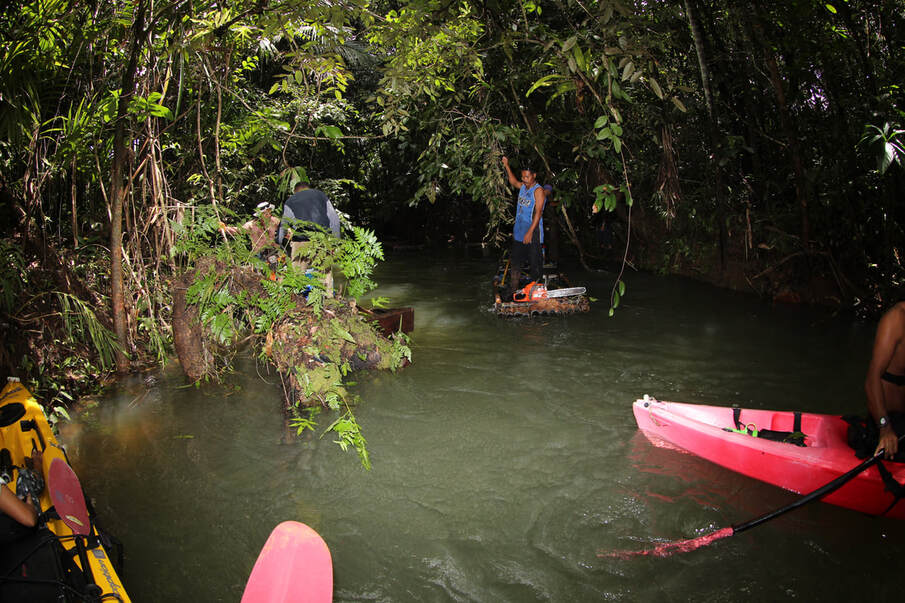
Ngchesar State and Paddling Palau clearing the way through the river.
It was astounding having a canopy of trees, dense pandanis and tangles vines enclosing us while we enjoyed the course the river had made. We followed the river to the mouth. We watched as the plants changed from fresh water inhabiting plants to salt water loving plants. We saw how the water went from crystal clear fresh water to dark and milky into brackish water eventually into the ocean we’re so familiar with.
Paddling Palau’s Bloyd, enjoying the scenery.
Drone Flying and posing with Ngchesar young boys and girls
We finished the scout at a dock where we made some new friends and hung out for a while before heading home to finalize the plan for the day to come.
We finished the scout at a dock where we made some new friends and hung out for a while before heading home to finalize the plan for the day to come.
Drone Flying and posing with Ngchesar young boys and girls
Because of the high number of kayakers, the day before the project we hauled the kayaks to Ngchesar where they would stay with some of the Paddling Palau Crew till the morning. We of course had to get back on the river for one more fun but final run. All was smooth and perfect.
Adam, Douglas & Cobi, our overnight crew.
prepared for 65 guests
The next day we met with the researchers and EQPB at PICRC to give a presentation and briefing before heading to Ngchesar.
We were enthused to see the guests. We made the delivery as smooth as possible, getting everyone on the water and down the river to enjoy. In no time, we had over 20 people flowing down the river to adore and experience what we had just days before. It was fun to see others enjoying the beauty of the land. Although our crew doesn’t visit this river often, we were enthused to be a part of working with our community and sharing the beauty with others.
We were enthused to see the guests. We made the delivery as smooth as possible, getting everyone on the water and down the river to enjoy. In no time, we had over 20 people flowing down the river to adore and experience what we had just days before. It was fun to see others enjoying the beauty of the land. Although our crew doesn’t visit this river often, we were enthused to be a part of working with our community and sharing the beauty with others.
We parted ways with the group at Jungle River Cruise where we hauled out the kayaks and loaded the truck and trailer to make runs back to Paddling Palau Head Quarters in Malakal. It made a great day after an incredible delivery. We had an amazing experience with the Shimizu River and were proud to be a part of something that was bringing awareness over issues we feel are important. The bonding with the crew and excitement of new adventures fuel us for the busy season that is to come. We love this island and our beautiful land. We hope to continue to grow positive relationships with others like us that enjoy keeping this land pure.
Paddling Palau & Jungle River Cruise
Ron, Adam, Macstyl, Douglas & Udoud
Drone shot of land at the starting point of Shimizu River.
Shimizu River & Ngchesar Hills
Boat and Kayaks leaving the mouth, where the River meets the Ocean.
Onsite Crew for the day: Ron, Macstyl, EliLai, Udoud, Adam, Douglas, Cobi, Bloyd
Photos by Ron Leidich & EliLai Sugiyama
Video by Macstyl Sasao
Footage from Macstyl Sasao, EliLai Sugiyama & Cobi Jones
Written by EliLai Sugiyama
]]>Photos by Ron Leidich & EliLai Sugiyama
Video by Macstyl Sasao
Footage from Macstyl Sasao, EliLai Sugiyama & Cobi Jones
Written by EliLai Sugiyama
The Palauan owl, Pyrroglaux podarginus, is a diminutive miniature of his forest cousins (the Scops Owls) from the genus Otus. Given that the Philippines possesses at least seven species within the genus Otus, it's most likely that the Palauan owl colonized from the West. It's not exactly clear when the owls first arrived in Palau, though that colonization event must've occurred long ago as the Palauan owl is not only endemic, but finds itself in the monotypic genus Pyrroglaux. The genus name comes from the Greek word pyro- meaning fire. This refers to the reddish plumage of the adult owl. Glaux is also Greek and simply means owl. The podarginus portion of the species name refers to the silver feet.
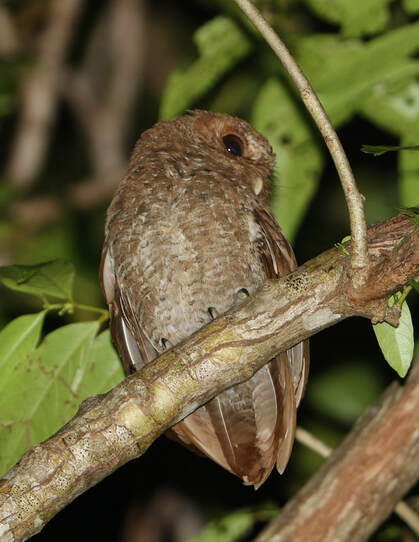
Every Palauan is familiar with the melodic call of this nocturnal forest dweller, though few residents have had the pleasure of seeing one up close. The Palauan owl ("Chesuch" in Palauan) hides deep in the forest by day, emerging at night to feast on geckos and insects. The best way to get a glimpse of this reticent raptor is to play back their call shortly after dark. These territorial little predators are intolerant of competition and will quickly respond to the intrusion. They'll perch above your head scolding the phantom intruder with load "whoops," until they realized that they've been duped. The owl will then quickly disappear back into the forest to resume its mysterious lifestyle.
On rare occasions a juvenile owl will fall from their nest with no ability to reunite with their caring parents. I rescued one stranded owl while leading a camping expedition, after the little bird had been blown into the ocean during a wild storm. We washed the salt water from the owls feathers and treated him to a meal of hamburger. After regaining his strength the bird with belly full, returned to the forest sometime in the night.
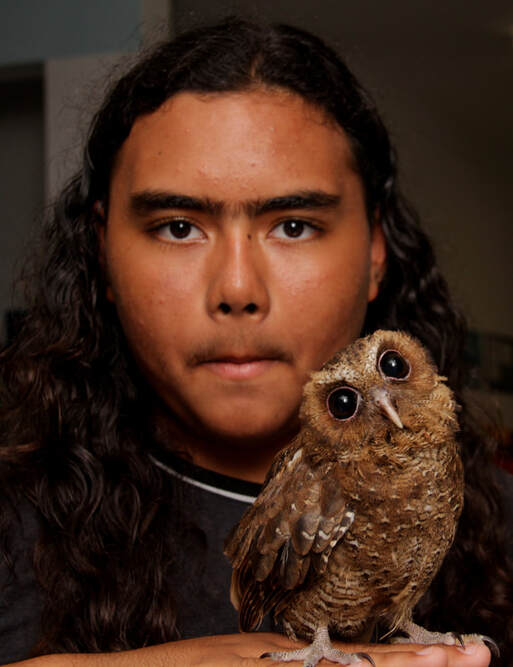
More recently an orphaned owl was brought to the caring hands of the scientists at the Coral Reef Research Foundation (https://coralreefpalau.org). In addition to studying Palau's mega-diverse marine bio-fauna, they also run a non-profit association known as PAWS (Palau Animal Welfare Society). PAWS has been instrumental in caring for dogs, cats, and stranded wild animals during their tenure in Palau. http://pawspalau.org/
My son Calvin Idek Leidich was very fortunate to attended a Robotics course at CRRF and was able to enjoy a close encounter with the little owl, appropriately named Owlaxander the Great. The precocious fledgling nibbled gently at Calvin's hands until a bond of trust was formed. Once Owlaxander understood he was safe and secure he hopped onto Calvin's hands and enjoyed a little tour of the center. Research Biologist Gerda Ucharm has been feeding Owlaxander chicken and geckos. Gerda is hoping that he'll return to the wild, but fears that he's gotten too comfortable with the domestic lifestyle. Owlaxander apparently prefers soft fluffy towels to his woody perch and turns his beak away from live prey. So much for the call of the wild!
More recently an orphaned owl was brought to the caring hands of the scientists at the Coral Reef Research Foundation (https://coralreefpalau.org). In addition to studying Palau's mega-diverse marine bio-fauna, they also run a non-profit association known as PAWS (Palau Animal Welfare Society). PAWS has been instrumental in caring for dogs, cats, and stranded wild animals during their tenure in Palau. http://pawspalau.org/
My son Calvin Idek Leidich was very fortunate to attended a Robotics course at CRRF and was able to enjoy a close encounter with the little owl, appropriately named Owlaxander the Great. The precocious fledgling nibbled gently at Calvin's hands until a bond of trust was formed. Once Owlaxander understood he was safe and secure he hopped onto Calvin's hands and enjoyed a little tour of the center. Research Biologist Gerda Ucharm has been feeding Owlaxander chicken and geckos. Gerda is hoping that he'll return to the wild, but fears that he's gotten too comfortable with the domestic lifestyle. Owlaxander apparently prefers soft fluffy towels to his woody perch and turns his beak away from live prey. So much for the call of the wild!
By: Ron Leidich
]]>| What do you think of when you hear Medusa? For me, it's the Greek myth of Medusa. One of the most intriguing myths to me. Medusa was the child of two ancient ocean deities. A ravishingly beautiful maiden victimized by the goddess Athena out of jealousy. Turned into a monster with snakes for hair and a gaze that would turn those who looked into her eyes to stone. But did you know Medusa is also another name for jellyfish? Fitting if you compare the jellyfish body as her head and the tentacles to her serpent hair. In Palau our most well know lake and top attraction is our Jellyfish Lake. You swim amongst thousands of stingless jellyfish. The experience is quite peaceful and majestic. |
I recently went out on a day of adventure with some of my brothers from our RIKE team and we chose to take a break on a beach. We had heard of a lake being up and over the high peaks of the rock island and decided to explore. Moving into the rock island further through a swampy mud flat and into the forest, we began to climb the jagged limestone -- all of us anticipating the climb and how far our journey would take us. We finally came upon a our lake we had been searching for.
Visiting these exclusive lakes are always a lottery. Because the lakes are enclosed and the only water flowing in and out is through cracks, holes or tunnels through the limestone; you get a wild card of possibilities. It's not uncommon to see crocodiles in many of these lakes so we took caution and began to snorkel. Immediately we came across upside down jellyfish (Cassiopeia Andromeda).
Visiting these exclusive lakes are always a lottery. Because the lakes are enclosed and the only water flowing in and out is through cracks, holes or tunnels through the limestone; you get a wild card of possibilities. It's not uncommon to see crocodiles in many of these lakes so we took caution and began to snorkel. Immediately we came across upside down jellyfish (Cassiopeia Andromeda).
Does Cassiopeia or Andromeda ring a bell for anyone? For me no. At least the names. I was thrilled to hear there was another connection of jellyfish with Greek mythology and even more intrigued that it related to Medusa. Andromeda was Cassiopeia's daughter. Cassiopeia boasted that Andromeda was more beautiful than the sea nymphs and this offended Poseidon. He demanded Andromeda would be sacrificed to the sea monster. Perseus saved Andromeda by revealing the head of Medusa and turning the sea monster to stone. Oddly enough Medusa was pregnant when Perseus killed her and Poseidon's offspring sprang forth, Pegasus and Chrysaor. Chrysaora is also a type of Jellyfish or sea nettle.
Unlike the Golden medusa in jellyfish lake (Mastigias papua) these upside down jellyfish paralyze their prey with nematocysts and will cause a sting that is painful to humans. We continued and were surprised to see a carpet of these upside down jellyfish across the whole lake floor. So many they were also free floating.
Carefully moving through the labyrinth of Cassiopeia Andromeda we continued to explore the lake. Every corner new to discovery and thrilling yet daunting knowing that if the jellyfish felt threatened they could release their nematocysts (stinging cells) into the water.
Despite the uneasiness of the jellyfish the lake was eerie yet enchanting to me. Spots so visible and clear with light beaming through then into brackish water where you feel distorted. Mangrove roots with delicate sponges, anemone and oysters encrusted. There was a film along the bottom that looked like spooky smoke. It was intertwined by big mangrove roots with beautiful green algae covering them. Small shrimp all around a couple of fish made the small community of the lake.
We made our way back to the beach and fulfillment and joy overflow my soul. An experience and lake I will never forget. The best part is knowing its hidden, protected and will remain a secret only for those who come from this land to enjoy and see.
Unlike the Golden medusa in jellyfish lake (Mastigias papua) these upside down jellyfish paralyze their prey with nematocysts and will cause a sting that is painful to humans. We continued and were surprised to see a carpet of these upside down jellyfish across the whole lake floor. So many they were also free floating.
Carefully moving through the labyrinth of Cassiopeia Andromeda we continued to explore the lake. Every corner new to discovery and thrilling yet daunting knowing that if the jellyfish felt threatened they could release their nematocysts (stinging cells) into the water.
Despite the uneasiness of the jellyfish the lake was eerie yet enchanting to me. Spots so visible and clear with light beaming through then into brackish water where you feel distorted. Mangrove roots with delicate sponges, anemone and oysters encrusted. There was a film along the bottom that looked like spooky smoke. It was intertwined by big mangrove roots with beautiful green algae covering them. Small shrimp all around a couple of fish made the small community of the lake.
We made our way back to the beach and fulfillment and joy overflow my soul. An experience and lake I will never forget. The best part is knowing its hidden, protected and will remain a secret only for those who come from this land to enjoy and see.
By: EliLai Kei Sugiyama
]]>Two species of fresh water eel have been described in Palau's waters. Anguilla bicolor pacifica, commonly known as the Indian Fresh Water eel is the smaller of the two species growing to just over a meter long. The Giant Marbled (mottled) Eel, Anguilla marmorata, can grow to an astonishing 2.2 meters and weigh 20.5 kilograms (45 pounds)!
Biologists have described 19 circumglobal species in the family Anguillidae. Collectively known as short fin eels, the Anguillids are in fact true eels of the order Anguilliformes, which includes the more familiar Moray Eels (family Muraenidae). The short finned eels differ noticeably from their marine cousins due to the presence of prominent pectoral fins and a flattened head.
Biologists have described 19 circumglobal species in the family Anguillidae. Collectively known as short fin eels, the Anguillids are in fact true eels of the order Anguilliformes, which includes the more familiar Moray Eels (family Muraenidae). The short finned eels differ noticeably from their marine cousins due to the presence of prominent pectoral fins and a flattened head.
The life history of the short finned eels is also radically different from their salt water cousins. The adult Anguillids reside in fresh water where they feed fish, crabs, shrimp, and even frogs. Once they've reached sexual maturity they ultimately migrate to the open ocean where they then spawn in deep water environments. The free floating eggs hatch into Leptocephali larvae which then drift for months until finding their way into estuaries. At this point the little anguillids are known as "Glass Eels." As they continue to mature they'll begin to migrate into fresh water streams at which point they become known as "Elvers." After 8-20 years the Yellow Eels mature into Silver Eels at which point they're ready to migrate back out to sea for sweet spawning. The reproductive cycle of the eels makes them catadromous, which is essentially the opposite life history of the fresh water spawning salmon (anadromous).
| Searching for these elusive eels in Palau's waters is not easy, though it does take you into some especially stunning habitats. The fresh water rivers of Babeldoab lead to stunning waterfalls and clear water pools. The Giant Marbled Eels can be seen free swimming in these pools before disappearing into murky crevices. Even more bizarre is the presence of the eels in several of Palau's salt water lakes. The limestone islands of Palau boasts an astonishing 74 salt water lakes, several of which are topped with a fresh water lens. Apparently the saline content in several of these lakes is just tolerable enough for the eels to survive. |
In many of the villages in Palau, the Giant Marbled Eels are considered a delicacy and can be consumed skin and all, served with soy sauce, sugar, and oil. In other states and hamlets including Melekeok and Ngerbeched, Kitelel is considered to be a god and should never be harmed. For a handful of visitors interested in going well off the beaten path, the sight of these strange catadromous fish is a once in a lifetime memory.
By: Ron Leidich and Malcolm Meltel
]]>| We're all entranced by the sights and smells of the flowering plants. The Angiosperms or flowering plants have been attracting pollinating insects since the time of dinosaurs (The Cretaceous). The showy flowers entice birds, bats, butterflies, bees, and moths with the promise of juicy nectar and nutritious pollen. In return, the flowers only ask that their pollen be spread from flower to flower with the hope of fertilizing the next generation of seeds. Should seeds develop from successful pollination, the plant's next task is the dispersal of its propagules. In temperate zones Maple trees create "Helicopter Seeds" which spin wildly away from the parent tree riding the wind on their way to the forest floor. Oak trees create acorns which are then carried all over the forest by hungry squirrels and birds. In Palau, the primary mammalian disperser is the fruit bat, which can carry Pandanus & Breadfruit seeds to the most remote corners of the rock islands. The colorful fruit dove is more than happy to get carry the delicious fig fruits high up into the canopy of a host tree. The Mangrove & Littoral zone trees, shrubs, and vines use ocean currents to get their progeny from place to place. The coconut is perhaps the most famous example of an ocean dispersed seed. |
The creativity of the plant world seemingly knows no boundaries. The genus Pisonia is represented by two species of trees in Palau. The coastal Pisonia grandis can grow to staggering heights on the beach fronts of Kayangel atoll, but is essentially stunted on the limestone islands. It's forest dwelling cousin, Pisonia umbellifera, hides in the understory of the old growth forests, reaching heights of less than 25 feet. Both species achieve pollination using a rather unpleasant aroma which attract flies as their primary pollinator. But in terms of seed dispersal, the Pisonia genus takes a darker turn.
The seed cluster of Pisonia exude a sticky resin which can act like a miniature LaBrea Tar Pits, trapping small insects and even reptiles. But the goal of Pisonia is the hunt for big game: Birds are their primary target. Innocently alighting on a branch, the bird's feathers get caught on the seeds forcing the victim to flee in panic. More often than not, the sticky glue of the seeds adheres to the bird, until the feather is lost.... thus successfully dispersing the seeds.
| On occasion however, the bird is unable to free itself from the clusters of seeds. As the bird struggles for freedom, it only becomes more deeply ensnared by the sticky glue. Ultimately the bird becomes exhausted and perishes on the forest floor, providing not only the desired dispersal, but the bonus of fertilizer for the germinating seeds. On May 16, 2019 a group of visiting students and professors from Redlands University were able to witness this drama unfold on the island of Ulong. While hiking into the forest to inspect an ancient village site, the students watched a young Collared Kingfisher hop through the forest in obvious distress. The team of students gently captured the struggling bird by wrapping it up in t-shirt. Upon closer inspection, it was obvious that the Kingfisher had become ensnared in a cluster of seeds from the bird catching tree. With great affection, the students removed the seeds using coconut oil. The beautiful blue Kingfisher eventually regained its composure and flew back into the forest accompanied by cheers and applause from the students. | |
The Palauan name for Pisonia umbellifera is "Uudeuidarbekai" which translates into "the sticky glue of the megapode." The Megapodes are a chicken like bird which feed on insects and fruit in the forest understory. They frequently step on the fallen seeds of Pisonia during their forest walks and bounce around wildly trying to free their oversized feet.
By: Ron Leidich
]]>| Oby Roland is the newest member of the Paddling Palau family and she seems to have a natural gift for photography. While working as an assistant chef on a recent camping expedition, Oby picked up the guide's camera & telephoto lens and started snapping off a few frames. Oby grew up with a slingshot in her hand, so "hunting" with the camera felt perfectly natural. |
With her senses alert, Oby caught the sounds of a ruckus in the trees. It turned out to be a group of Palauan Fruit Bats squabbling over some ripe wax apples (Eugenia javanica). Oby took careful aim and snapped off a series of photos of the feasting flying foxes.
High on her first photographic success, Oby wandered down the beach searching for her next photo-victim. A gentle "tsweet, twseet, tweet" alerted her to the presence of a pair of endemic Palauan Flycatchers (Myiagra erythrops). With wide bills surrounded by minute hairs, the flycatchers are superbly adapted to catch small flying insects on the wing (hawking) or from the foliage (gleaning). Oby switched her camera to a high speed continuous setting so she could capture multiple images of the flycatchers, foraging in soft afternoon light.
| | When Oby returned to camp to show off her first images, the expedition guests and staff were stunned. Even the guide had never seen such perfect shots of the elusive flycatcher after 25 years of leading tours and photographing birds. Beaming with pride, Oby disappeared back down the beach in search of more photographic treasure. The entire team is looking forward to seeing what she'll capture next! |
This hike was the third attempt to access the interior of the forbidding limestone island, requiring climbs over vertical cliffs and descents into deep valleys. There are no trails or tracks to follow through the thick jungle. A compass, topographical map, and satellite image offered the only hints of the low valleys where the mysterious sink holes lie hidden under the canopy.
The hikers were soon greeted with a fascinating clue from ancient occupants. Cleverly arranged calcium rocks had been compiled so as to provide level terraces on the otherwise uneven ground. Palau's famous rock islands were previously inhabited by the "Chad era Chelbacheb" (rock island people) though the villages were abandoned mysteriously over five hundred years ago. Could this stone work be a remnant from these ancient inhabitants? Or might this have been the work station of another group of distant mariners?
It took over 45 minutes to scale the 250 foot high peak of Ulebsechel island. The climbers were in constant danger as the crumbling rock frequently collapsed beneath their feet during the ascent. Dodging blistering poison trees (Semecarpus venenosa) and sticker bushes added to the drama of the tropical heat and humidity. Fortunately the peak led to a series of cascading plateaus which made accessing the interior much easier than the introductory climb.
The group of hikers took a break from climbing when a tropical downpour swept through the forest replacing the dappled light with dark shadows. The tropical squall lasted only ten minutes and was followed by a chorus of bird calls and an unexpected visitor. Slithering over the moss covered rocks, a cryptic Dwarf Boa emerged, tasting the air with his forked tongue for hints of potential meals (skinks) or predators (kingfishers). The presence of a boa in Micronesian is a bit of a biogeographical anomaly. The Family Boidae is of New World Origins, being largely ecologically replaced by the Old World Pythons. Boas and Pythons differ in their modes of reproduction with Boas giving birth to live young after the formation of eggs inside the females body (ovoviviparous) while Pythons lay eggs (oviparous).
At a distant point in the past the Palauan Boa's ancestors rafted across the Pacific and struck landfall in Palau. Natural Selection favored individual snakes with smaller body sizes as the available prey in Palau was limited to small lizards. Thus over time, the Palauan Boa speciated in isolation to become an endemic dwarf. The evolutionary process of dwarfism is common on remote islands with Dwarf Mammoths & Stegodons being two mammalian examples.
The Palauan Boa, Candoia superciliosa, is a harmless species lacking venom and possessing a calm disposition. After enduring the cold rain the little dwarf gladly coiled himself around the warm hands of Cyandal "CY" Williams. With renewed enthusiasm the warmed up little reptile slipped over the moss covered rocks and disappeared into the limestone crevices.
The Palauan Boa, Candoia superciliosa, is a harmless species lacking venom and possessing a calm disposition. After enduring the cold rain the little dwarf gladly coiled himself around the warm hands of Cyandal "CY" Williams. With renewed enthusiasm the warmed up little reptile slipped over the moss covered rocks and disappeared into the limestone crevices.
After another hour of bouldering and vine swinging, additional clues to the island's past emerged. Shattered rocks glistened in the dappled forest light, forcing everyone to stop in their tracks. The crystal calcite strewn about the valley was evidence of a once massive cave system which had collapsed with an earth shattering tremor. Impervious to erosion, the flowstone remains as a testament to the past. The fragile nature of the crystals made them virtually useless to Palauans as they were too brittle for spear points. Another group of islanders however found the shining crystals irresistible... The Yapese sailed for 280 open ocean miles to quarry the calcite into effigies of the full moon.
After a few more cautious steps through the forest our suspicions were confirmed. Though covered with mosses after hundreds of years of abandonment, the unmistakable outline of a forgotten stone disc emerged before our eyes. Clearly the giant stone had been shattered during the carving process and was left behind as proof of the Yapese efforts.
Buoyed by another epic discovery the explorers continued on through a maze of spiraling trees and giant lianas. An abandoned taro patch was further evidence that the Yapese has quarried stone in the area for several seasons. After reaching the lowest point of the topographical map however, it became obvious that the fabled sink holes would remain hidden a little longer. With fading daylight, it was time to work their way out of the deep forest. The dreams of a fresh water oasis lost in a limestone forest would have to wait for another day. For now the explorers departed with memories of a forest dwarf and forgotten treasure.
]]>Buoyed by another epic discovery the explorers continued on through a maze of spiraling trees and giant lianas. An abandoned taro patch was further evidence that the Yapese has quarried stone in the area for several seasons. After reaching the lowest point of the topographical map however, it became obvious that the fabled sink holes would remain hidden a little longer. With fading daylight, it was time to work their way out of the deep forest. The dreams of a fresh water oasis lost in a limestone forest would have to wait for another day. For now the explorers departed with memories of a forest dwarf and forgotten treasure.
You can also check out the video via this link. :)
https://www.dropbox.com/s/1593qyg689zs192/Connecting%20with%20Our%20Past.mp4?dl=0
Title and Video credits to our friend Monty Hempel.
]]>https://www.dropbox.com/s/1593qyg689zs192/Connecting%20with%20Our%20Past.mp4?dl=0
Title and Video credits to our friend Monty Hempel.
Palau boasts 22 different species of marine mammals and we expect this list to continue to grow with continued research efforts. One of the more enigmatic visitors to Palau is known as the Risso's Dolphin, Grampus griseus. Weighing in at over 1,000lbs they are rather large for a dolphin. In fact they belong to a subfamily known as the Globicephalinae which includes such heavyweights as the Shortfin Pilot Whale (over 6,000lbs) and the False Killer Whale (up to 3,000lbs). The Risso's Dolphin is easily distinguished from its relatives by the intense degree of scratching on their bodies, particularly among the males. In older males healed scars are so numerous that the head appears to be white.
The Risso's Dolphin is a circumglobal species found in both temperate and tropical waters. Though they do not reside in Palau year around we do enjoy frequent sightings of these charismatic beasts. Though they typically shy away from boats, they are nevertheless playful among their own kind and can be frequently seen spy-hopping and making athletic full bodied leaps out of the water. We've even witnessed them swimming the "backstroke" with their pectoral fins pointing skyward. The Risso's Dolphins signature move however is called Tail Lobbing where they stand vertically in the water with tail waving in the wind.
On May 17, 2018 a group of researchers and students from Redlands University joined the Paddling Palau team for a whale watching outing. With glassy calm seas it didn't take long to spot the characteristic dorsal fins of a pod of Cetaceans. The waving tails left no doubt as to the identity of this pod of dolphins. To reduce our intrusive noise signature captain RD shut the motors down allowing us to observe the Risso's Dolphins from a distance. A careful headcount revealed a pod of between 25 to 30 individuals including at least one calf.
Within minutes of kissing the Spinner Dolphins goodbye, the whale watchers were rewarded with another mysterious sight. A group of small black dorsal fins floated quietly at the surface only 100 meters from the boat. Rather than rush in and potentially scare a shy species, the Cetacean team scanned the pod with binoculars and telephoto lenses. With only six to ten individuals in the pod, the list of potential candidates was immediately reduced. Melon Headed Whales for example are typically found in super pods of several hundred individuals. A clue immediately emerged as a tiny tail fluke slapped repeatedly on the surface in an exuberant gesture of play. The all black fluke further narrowed down the choice of species. As the Dolphins were much too small to be Pilot Whales or False Killer Whales, the next most obvious candidate became Pygmy Killer Whales, Feresa attenuata.
Weighing in at less than 400lbs, these reclusive "Black Fish" are rarely seen in Palau's waters. In fact they are most commonly encountered in the company of Sperm Whales whose presence they seem to enjoy. As a lone head broke the surface the white lips and rounded head left no doubt as to the species identification. Biologist Ron Leidich has been tracking a trio of Pygmy Killer Whales for the last three years, but this was clearly not the same group. This pod contained between eight to ten individuals including the playful calf. One elderly adult had characteristic scarring on the dorsal fin which had never been previously photographed in Palau.
Weighing in at less than 400lbs, these reclusive "Black Fish" are rarely seen in Palau's waters. In fact they are most commonly encountered in the company of Sperm Whales whose presence they seem to enjoy. As a lone head broke the surface the white lips and rounded head left no doubt as to the species identification. Biologist Ron Leidich has been tracking a trio of Pygmy Killer Whales for the last three years, but this was clearly not the same group. This pod contained between eight to ten individuals including the playful calf. One elderly adult had characteristic scarring on the dorsal fin which had never been previously photographed in Palau.
The brief encounter left more questions than answers. Is this pod a group of passage migrants or do they reside in Palau? Is their arrival a seasonal event or do they simply randomly wander throughout the tropics? Is there a chance that Palau serves as a calving ground or nursery for the newborn whales? Only one fact was answered with assuredness on this outing: Palau hides a treasure chest of fascinating species and we've only begun to uncover their mysterious lives and complex social systems.
]]>| Eight year old Kendra Miluu Leidich was born and raised on the picturesque tropical island of Palau, located in the remote Western edge of Micronesia. Born of an American father and Palauan mother, she's grown up with two languages and a pair of contrasting cultural values. Her earliest memories include snorkeling from the safety of her father's back while peering over his side in search of sea horses, turtles, and multi-colored tropical fish. A typical weekend for this Palauan youth may include building sand castles on pristine beaches and searching for dolphins on the front of the family boat. Her Palauan family customs, also held over weekends, may include traditional first birth ceremonies or house warming parties. Despite this idyllic Micronesian upbringing, many of the influences surrounding little Miluu have been Western. From the television to the radio and even her school text books, English is becoming the dominant language. Western materialism has subtly shifted the Micronesian society's priorities away from clan cohesion and in the direction of more individual pursuits. The dreams of the Western world have found their way into the hearts and minds of even the most remote islands of Oceania. |
And then, one Disney movie swung the pendulum back in the direction of island pride and traditional values. Moana, from a remote fictional island in Polynesia is faced with a crisis effecting her island and people. She must set sail over the horizon in a traditional canoe to help save her people. The impact on Miluu was immediate. Inspired by a new role model, Miluu started asking a new set of questions: Can Palauans still make sailing canoes? What materials do "my people" use to make sails, paddles, & outriggers? How many friends could I fit on a sailing canoe?
The moment of opportunity was not lost on Miluu's American father. Tragically, the art of building traditional sailing canoes has not been practiced in Palau since before WWII. Palau is however quite fortunate to have a group of islanders in their midst which still rely on the breadfruit hull of a canoe and the woven Pandanus sails for their survival. These are the atoll dwellers. Scattered amongst the high islands of Oceania are the coral cays or atolls, characterized by a low lying sandy islands enclosing a shallow water lagoon. For the last three thousand years, brave Polynesian and Micronesian navigators have located and colonized these remote island outposts. Despite the tropical beauty of these tranquil environments, living on a sandy beach comes with risks. The vulnerability of typhoons and the stress of food shortages have necessitated a unique cultural adaptation among the atoll dwellers: mobility. And thus the traditional canoe to this day continues to be a source of pride and dire necessity.
The moment of opportunity was not lost on Miluu's American father. Tragically, the art of building traditional sailing canoes has not been practiced in Palau since before WWII. Palau is however quite fortunate to have a group of islanders in their midst which still rely on the breadfruit hull of a canoe and the woven Pandanus sails for their survival. These are the atoll dwellers. Scattered amongst the high islands of Oceania are the coral cays or atolls, characterized by a low lying sandy islands enclosing a shallow water lagoon. For the last three thousand years, brave Polynesian and Micronesian navigators have located and colonized these remote island outposts. Despite the tropical beauty of these tranquil environments, living on a sandy beach comes with risks. The vulnerability of typhoons and the stress of food shortages have necessitated a unique cultural adaptation among the atoll dwellers: mobility. And thus the traditional canoe to this day continues to be a source of pride and dire necessity.
Miluu's dream of a sailing canoe came to the attention of a group of atoll dwellers residing in Palau. To the South West of Palau are the inhabited island groups of Sonsorol and Hatohobei. Between Yap and Chuuk in the Federated States of Micronesia can be found Ulithi, Woolei, Ifalik, and Satawal. Despite the great distances separating these people, they are bound by one language, loosely described as "Carolinean." And these warm hearted islanders agreed to turn Miluu's dream into a reality....
]]>Calvin Idek Leidich, an eighth grader at Koror Elementary School returned to Palau on Saturday, December 9th after a father-son dive adventure in Chuuk. Prior to departing for the F.S.M. Calvin had logged over 250 dives in Palau, Indonesia, and Costa Rica. He's made over fifty dives on Palau's epic WWII shipwrecks and was interested in learning more about the US fast carrier strikes of 1944 and the devastation they brought to Japan's combined fleet. To prepare for the SCUBA adventure & history lesson, Calvin studied battle maps, read WWII books, and watched Pacific Theater documentaries.
Calvin's first dive in "Truk Lagoon," was to the famous Fujikawa Maru, which was sunk on February 18, 1944 (about six weeks before the aerial bombardment of Palau). The Fujikawa was on a mission to deliver aircraft to Chuuk for the island's defense. Though most of her aircraft had been offloaded prior to the US bombardment, Calvin still found four Japanese Zero fighter aircraft in cargo hold #2. He carefully avoided live ammunition and explosive rounds in the cargo hold, eventually positioning himself next to the aircraft's cockpit where the pilot's seat, instrument panel, and gauges could still be seen. During Operation Hailstone, US dive bombers & torpedo bombers made direct hits on the Fujikawa over a two day period until finally she succumbed to fires and flooding.
The most unusual dives in Chuuk were on sunken aircraft and a Japanese submarine. Discovered in only 60 feet of water near Eten Island are the nearly intact remains of a Mitsubishi G4M Type 1 Attack Bomber, code named "Betty" by the Americans. Calvin carefully swam through the fuselage of this vintage aircraft emerging from the nose cone, which during the war held 7.7mm defensive machine guns. Even more interesting was a dive on a Kawanishi H8K flying boat, code named "Emily." During the war this massive four engine bomber was bristling with guns and could ward off attacks from the best of the American fighter aircraft. Tragically the remains of a submarine, I-169, are left on the bottom of the lagoon after the crew inadvertently dove to avoid an American bombardment. With hatches left open, the submarine quickly flooded trapping the crew inside.
Calvin's first dive in "Truk Lagoon," was to the famous Fujikawa Maru, which was sunk on February 18, 1944 (about six weeks before the aerial bombardment of Palau). The Fujikawa was on a mission to deliver aircraft to Chuuk for the island's defense. Though most of her aircraft had been offloaded prior to the US bombardment, Calvin still found four Japanese Zero fighter aircraft in cargo hold #2. He carefully avoided live ammunition and explosive rounds in the cargo hold, eventually positioning himself next to the aircraft's cockpit where the pilot's seat, instrument panel, and gauges could still be seen. During Operation Hailstone, US dive bombers & torpedo bombers made direct hits on the Fujikawa over a two day period until finally she succumbed to fires and flooding.
The most unusual dives in Chuuk were on sunken aircraft and a Japanese submarine. Discovered in only 60 feet of water near Eten Island are the nearly intact remains of a Mitsubishi G4M Type 1 Attack Bomber, code named "Betty" by the Americans. Calvin carefully swam through the fuselage of this vintage aircraft emerging from the nose cone, which during the war held 7.7mm defensive machine guns. Even more interesting was a dive on a Kawanishi H8K flying boat, code named "Emily." During the war this massive four engine bomber was bristling with guns and could ward off attacks from the best of the American fighter aircraft. Tragically the remains of a submarine, I-169, are left on the bottom of the lagoon after the crew inadvertently dove to avoid an American bombardment. With hatches left open, the submarine quickly flooded trapping the crew inside.
Calvin's favorite dives took him to some of the deepest waters of the lagoon. On the Nippo Maru Calvin posed for photos next to a Type 95 light tank and cannons destined for the island's defense. On the Hoki Maru, Calvin slipped into a cargo hold full of utility trucks, bulldozers, and a steam roller. Perhaps most interesting of all was the Heian Maru which was a pre-war luxury liner, converted into a submarine tender. Calvin dove within touching distance of torpedoes and attack periscopes. The Japanese Long Lance Torpedo was powered by 100% oxygen and gave the Japanese a decisive advantage over the American's inferior Mark 14 torpedo.
The wrecks today are covered with a luxurious assortment of soft corals, sponges, and marine life adding a stunning splash of color to the otherwise rust colored hulks. While Calvin's father photographed cannons, tanks, and aircraft with a wide angle lens, Calvin took macro shots of the colorful reef fish, corals, and invertebrates. He also carried a Go-Pro to shoot video of Chuuk's best kept secret, the Indo-Pacific Bottlenose Dolphins. Known scientifically as Tursiops aduncus, the species known range extends from East Africa to the Solomon Islands. Related to the better known Oceanic Bottlenose, Tusiops truncatus, the Indo-Pacific species had never officially been described from Micronesian waters. Calvin's images have thus added an important clue to our understanding of Cetaceans in the Caroline Islands. More importantly, these wild dolphins are exceptionally playful and will swim with visitors for hours when the mood is right.
This 13 year old Palauan has now logged over 170 dives including expeditions to Komodo Island which is home to the famed giant lizards, the Komodo Dragons (Veranus komodoensis). Earlier this year he dove amongst the schooling Hammerheads and Whale Sharks of the Cocos Islands in Costa Rica. Calvin has kept a photographic log book to carefully document all of his adventures. Before age 12 Calvin had already travelled to all seven continents! During his upcoming summer holidays he plans on diving the Red Sea after a family trip to Africa. When asked what motivates him to travel so far from home, Calvin said that the planet is his classroom and he hopes to experience as much as he can.
The wrecks today are covered with a luxurious assortment of soft corals, sponges, and marine life adding a stunning splash of color to the otherwise rust colored hulks. While Calvin's father photographed cannons, tanks, and aircraft with a wide angle lens, Calvin took macro shots of the colorful reef fish, corals, and invertebrates. He also carried a Go-Pro to shoot video of Chuuk's best kept secret, the Indo-Pacific Bottlenose Dolphins. Known scientifically as Tursiops aduncus, the species known range extends from East Africa to the Solomon Islands. Related to the better known Oceanic Bottlenose, Tusiops truncatus, the Indo-Pacific species had never officially been described from Micronesian waters. Calvin's images have thus added an important clue to our understanding of Cetaceans in the Caroline Islands. More importantly, these wild dolphins are exceptionally playful and will swim with visitors for hours when the mood is right.
This 13 year old Palauan has now logged over 170 dives including expeditions to Komodo Island which is home to the famed giant lizards, the Komodo Dragons (Veranus komodoensis). Earlier this year he dove amongst the schooling Hammerheads and Whale Sharks of the Cocos Islands in Costa Rica. Calvin has kept a photographic log book to carefully document all of his adventures. Before age 12 Calvin had already travelled to all seven continents! During his upcoming summer holidays he plans on diving the Red Sea after a family trip to Africa. When asked what motivates him to travel so far from home, Calvin said that the planet is his classroom and he hopes to experience as much as he can.
Storm winds from the SW prevented our team from venturing any further out than Ngeruktabel Island. We tucked the boat into "Botany Bay," which is a secluded cove with overhanging Ficus trees dripping with ferns and epiphytes. It proved to be the perfect site to search for orchids.
One of the first discoveries was a grove of Shooting Star Orchids, Diplocaulobium elongaticolle in mass bloom. The Ficus tree they were clinging to had spontaneously shed its leaves exposing the orchids to direct sunlight. The added heat stress may explain why so many orchids produced flowers simultaneously.
Shortly thereafter Benny spotted Bulbophyllum clandestinum which had previously escaped the view of the Paddling Palau team. With a microscopic flower and miniature leaves it was not surprising that such a "clandestine" species remained unknown to the group of kayak guides.
The gem of the day however proved to be the discovery of Oberonia palawensis. As the name suggests, this is one of Palau's 28 endemic species. Though well known to science, this thrilling orchid had never been seen by the Paddling Palau team. Bathed in soft light, the orchid made an idyllic photo subject as they were bearing both flowers and fruits. The hair like seeds are contained within a pod. When the pod dries and bursts open, the seeds are cast out through Ballistic Dispersal. Benny informed us that the seeds contain no endosperm (the nutrients of the seeds). This allows them to remain light weight and float away on air currents. Upon settling, they must then seek out the company of mutualistic fungus, which subsequently feed the germinating orchid until the plant can photosynthesize on its own (and presumably pay back its debt to the fungus).
| With a keen interest in Etymology, we ended the day with a bit of online research. It turns out the genus name Oberonia was applied in reference to Oberon, the Fairy King of Medieval & Renaissance literature. In William Shakespeare's Midsummer Night's Dream, Oberon is the king of all fairies and is fighting for custody with his wife Titania over their child. | |
Much like the King of Fairies, the Oberonia flowers live in hiding and are difficult to find.... and even tougher to photograph! With over 700 native plants, Palau is full of hidden treasures just waiting to be discovered.
]]>One of these species in particular makes for an exceptional case study. The Swinhoe's Snipe breeds in Northern Siberia in June & July flying as far South as Northern Australia in the winter. Yes, there truly is a species known as a Snipe. In fact there are at least 25 described species of these wading birds found within three genera. The Snipes are all characterized by a long bill with which they probe into the mud for a variety of invertebrates. Impressively, their bill is equipped with highly specialized filaments leading to sensitive nerve cells. Thus even when the bill is submerged in mud or water and completely out of sight, the Snipes can detect their prey by feel! They even have the ability to feed with their bill closed using a slurping action to deliver prey through their straw like bill.
Photographing a snipe can be a monumental task. They are highly cryptic, excessively shy, and difficult to approach. They tend to hide in tall grasses and marsh lands and will disappear into the bush when they feel threatened. When pushed to flight, they take off with monumental speed all the while making numerous cuts and dives. Nineteenth century hunters found them so difficult to shoot on the wing, that any marksman who could knock a Snipe out of the sky became known as a sniper. No kidding, that's the origin of the word Sniper!
Palau's commitment to protecting wetland habitat gives the snipes and their migratory relatives a fighting chance at survival in the midst of an ever changing global environment. Take the time to get to know some of our visitors and their fascinating life stories. The migratory birds add another chapter to Palau's global appeal as a wildlife sanctuary and pristine natural habitat.
From the air or by boat the islands appear to be lush and green. A closer look at the Botanical assemblage reveals a classic struggle to survive on a rocky, waterless, and nutrient poor environment. Given Palau's staggering marine biodiversity, most visitors arrive in Palau with dreams of multi-colored fish, giant mantas, teaming sharks, and pristine coral gardens. Few adventurers take the time to access the interior of the limestone forests. That's a tragic shame as the Botanical treasures of the Micronesian forests reveal some awe inspiring gems. Not only are the trees and flowers stunningly beautiful but they additionally highlight some magnificent adaptations to "Life on the Limestone."
On Saturday September 23rd I paddled into the labyrinth of Palau's rock islands with my two children and some special friends. Our destination was The Valley of the Crotons. I named the site after the beautiful shrubs which are non-native to the limestone environments. Thus this valley was once inhabited or utilized by the people of the rock islands, "Chad era Chelbacheb," who abandoned their villages mysteriously over 500 years ago. This exceptional stretch of forest hides some of Palau's most precious species of trees, shrubs, and orchids.
After a short jaunt into the forest we stopped to admire and photograph the colossal buttresses of the native Breadfruit Tree, Artocarpus mariannensis. The seeds can be boiled and eaten while the massive trunks have been used to make the hulls ocean going canoes. The admirable buttresses at first glance would appear to be an adaptation which increases the structural integrity of the trees within a rocky habitat. The solid limestone prevents tap roots from penetrating into the substrate, so this explanation sounds quite logical. However, more recent research suggest that the primary function of the buttress is to increase the surface area for gas exchange. Regardless of function, sitting beneath these magical life forms is a transformative experience.
We continued our journey deeper into the canopy covered forest when my daughter spotted an irresistible natural jungle gym. She scampered over boulders and through thick vines to reach the towering prop roots of a strangling fig tree, Ficus microcarpa. The strangling fig begins its life, not on the forest floor like most hard working seeds, but at the top of the canopy, thanks to its delectable fruit. Native pigeons and doves consume the fruit then subsequently deposit the seeds (with fertilizer) on a host tree. The sprouting Ficus then spreads its branches above its host, while dropping its tendril like roots around the host's trunk. The unfortunate victim of the strangler eventually succumbs to starvation after the Fig leaves and branches blanket the host's canopy. Eventually the host tree will decompose leaving a perfect "cast" within the spiral of entangled Fig roots. This natural Botanical chimney provides a most excellent play ground for adventurous 8 year olds with an affinity for heights!
Our final destination on the trail of the Botanically incredible, led us to a grove of bizarre trees known as Elaeocarpus rubidus. Sprouting from the base of the trees is a Rastafarian-like tangle of "Dread Lock" roots, which carpet the limestone rocks below. Like a soft woven matt, the sprawling roots make an ideal site for an afternoon nap beneath the cool shade of the forest. When not entertaining human visitors, the Broom Roots as they are often referred once again function to assist in gas exchange.
As an air breathing mammal we can relate well to a tree's need to "breath" through its roots. Like us, each tree needs to find a niche, secure a source of water and nutrients, and grow. Ultimately, they flower, produce seeds, and disperse their propagules far and wide to continue the circle of life. As my own little offspring meandered back down the track to our waiting kayaks, I stopped to consider how much we have in common with the quiet giants we humbly walk amongst.
